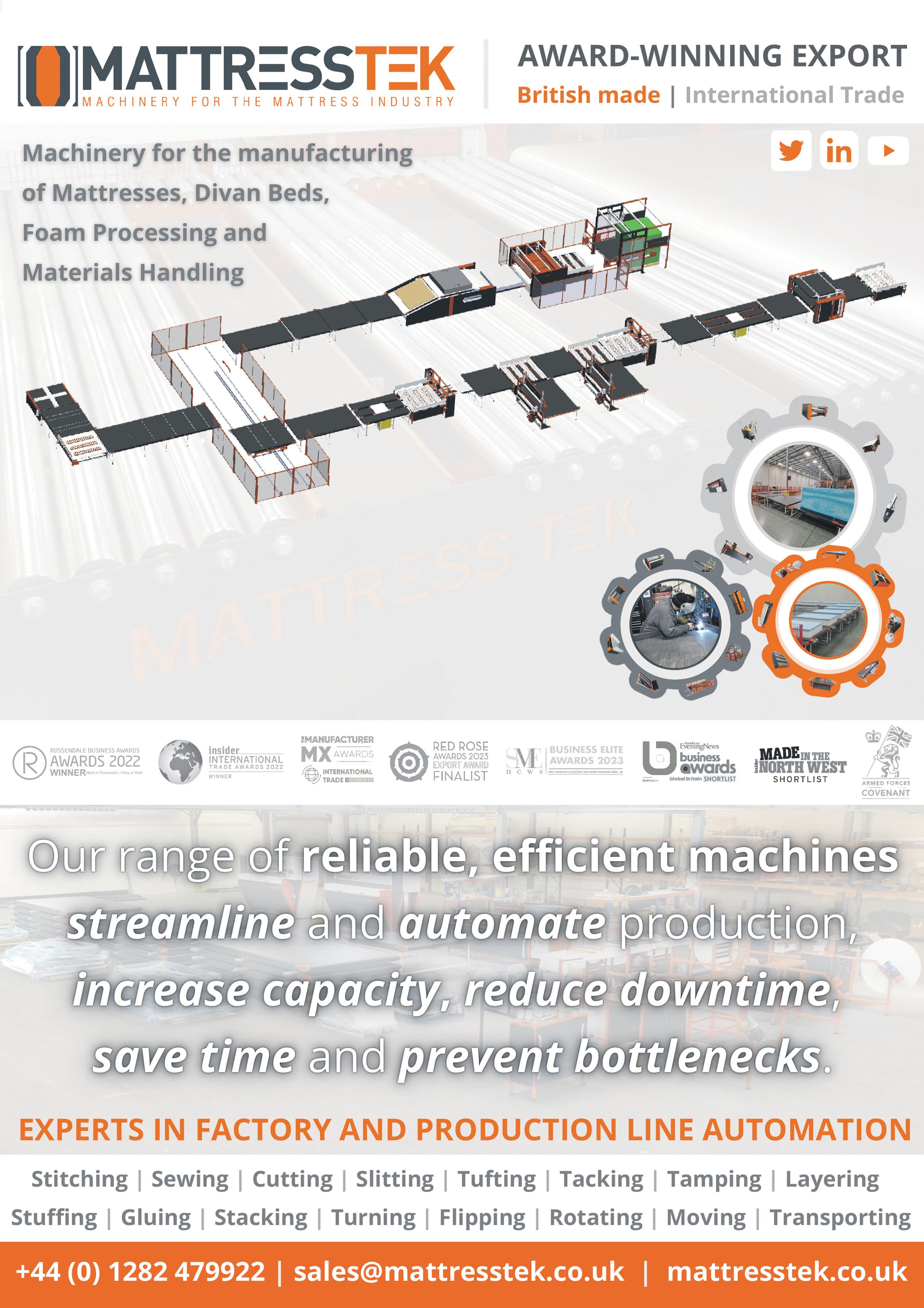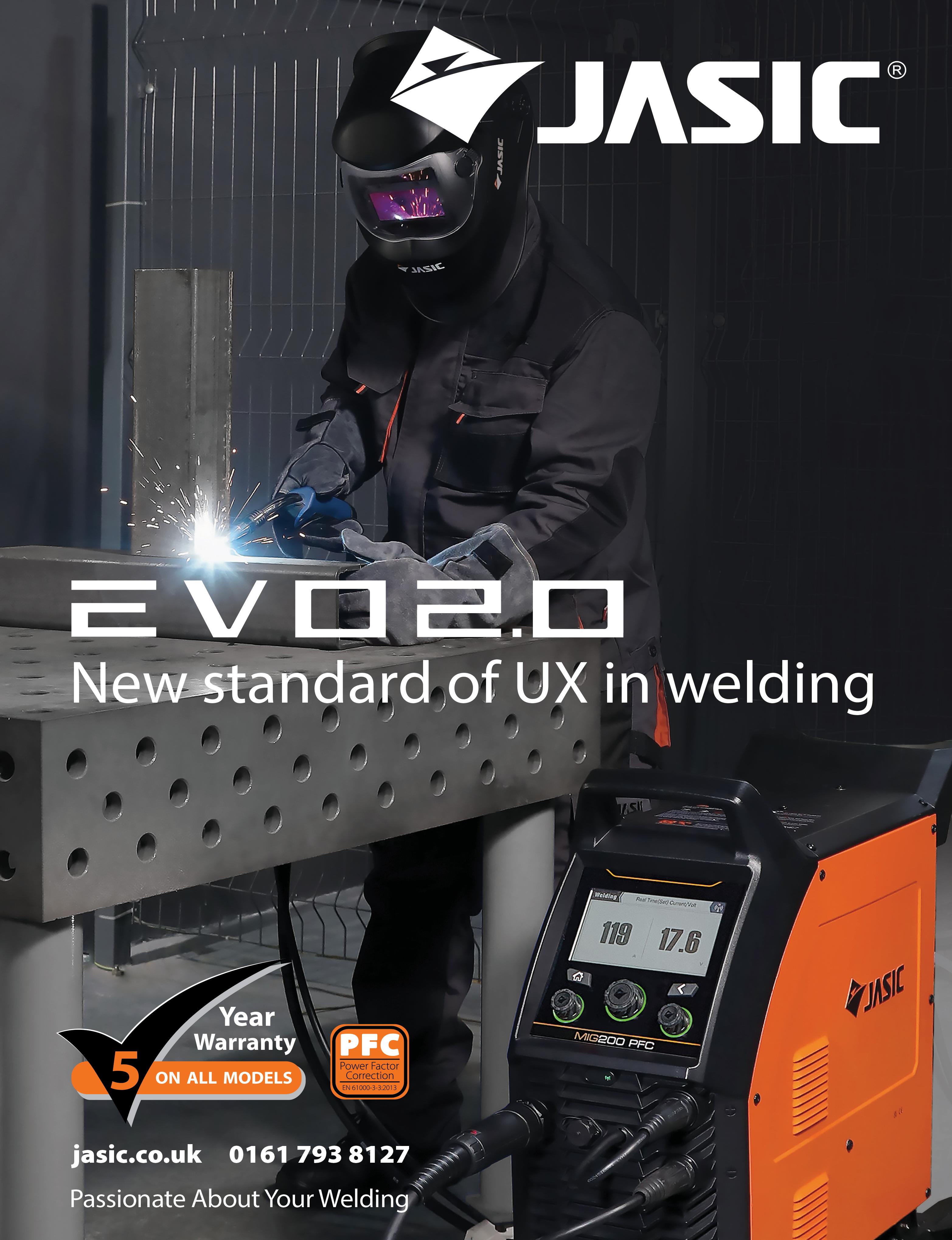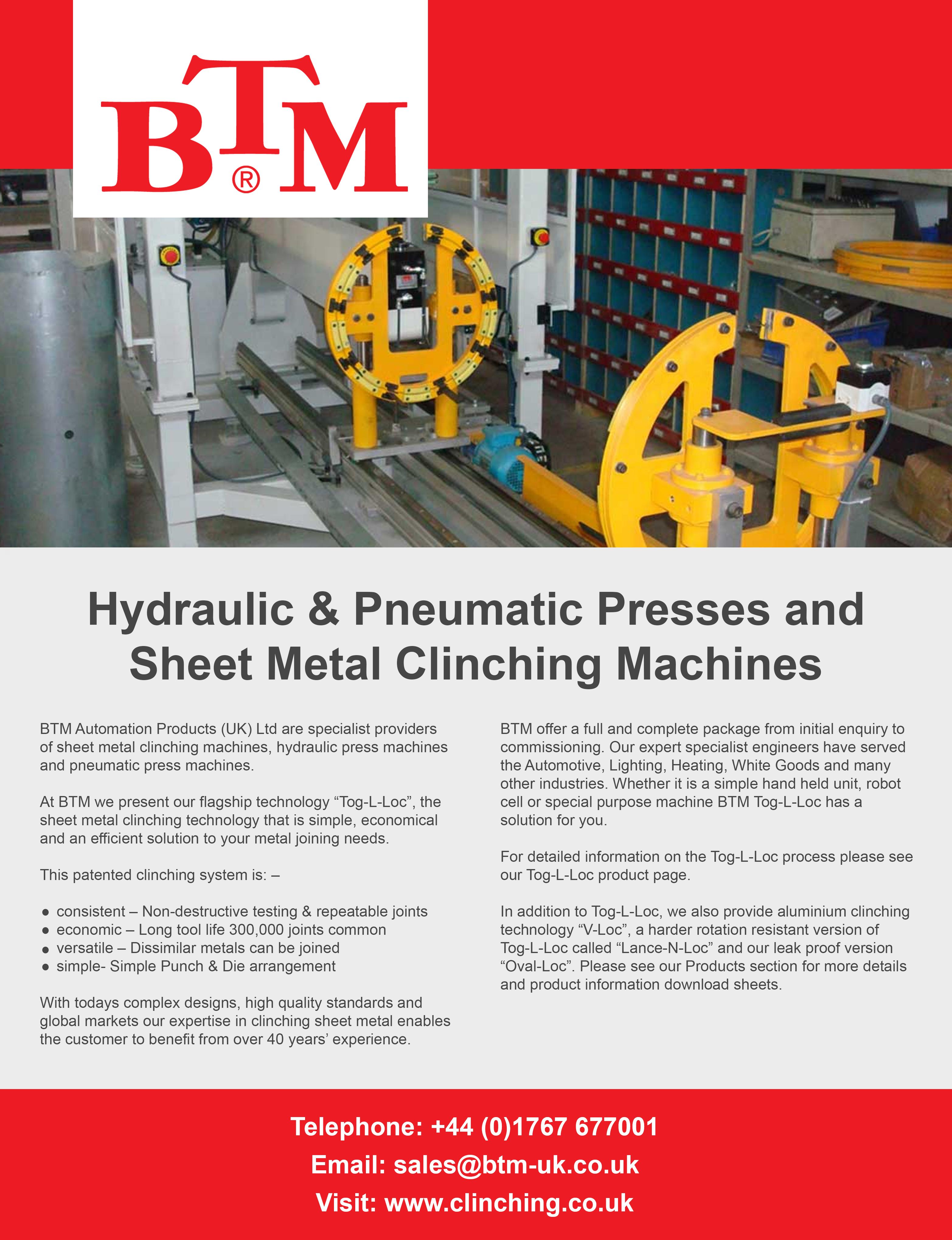

Lascar Electronics air quality product range: enhancing environmental monitoring and safety
In today's rapidly changing world, the importance of monitoring and improving air quality cannot be overstated. Lascar Electronics, a leading provider of data logging and monitoring solutions, offers a comprehensive air quality product range that empowers organisations to proactively address environmental concerns. With cutting-edge technology and a commitment to excellence, Lascar Electronics continues to deliver innovative solutions for efficient and accurate air quality monitoring.
We understand that air quality monitoring needs vary across industries and sectors. That's why our product range caters to diverse applications, from indoor environments such as offices, schools, and healthcare facilities to outdoor settings like industrial sites and construction zones. By offering a wide array of devices, Lascar Electronics enables organisations to effectively monitor air quality parameters and take appropriate actions to ensure the well-being of their employees and the surrounding community.
Our devices are equipped with state-of-the-art sensors capable of accurately measuring key parameters such as particulate matter (PM2.5 and PM10), carbon dioxide (CO2) levels, volatile organic compounds (VOCs), temperature, humidity, and air pressure. Our products undergo rigorous calibration processes to guarantee reliable and consistent performance, providing users with peace of mind knowing that their air quality data is accurate and trustworthy.
Our air quality monitors enable real-time
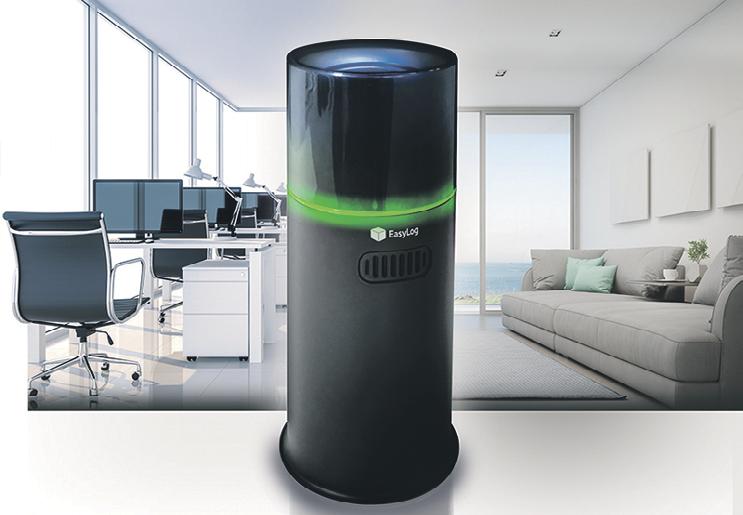
monitoring and provide instant alerts. This feature allows users to promptly respond to any deviations from acceptable air quality levels. Whether it's a sudden increase in particulate matter concentration or a rise in CO2 levels beyond the recommended threshold, the monitors alert users via visual indicators, audible alarms, or through connected systems such as mobile apps or cloud-based platforms. This immediate notification empowers organisations to take swift corrective measures, ensuring a healthy and safe environment for all.
Lascar Electronics understands that effective air quality management requires comprehensive data analysis. Our air quality product range seamlessly integrates with data logging platforms and software, enabling organisations to collect, store, and analyse air quality data over time. This integration allows for the identification of patterns,

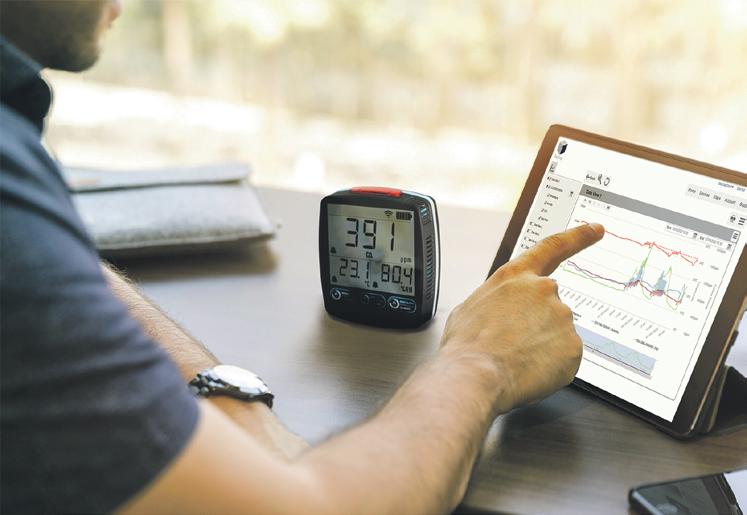
trends, and potential sources of air pollution. Armed with this knowledge, your organisations can make informed decisions, implement targeted interventions, and continuously improve air quality standards.
Lascar Electronics’ air quality product range offers a comprehensive and reliable solution for environmental monitoring and safety. By providing precision instruments, real-time alerts, and seamless data integration, Lascar Electronics empowers organisations to proactively address air quality concerns across various settings. As the importance of air quality management continues to grow, Lascar Electronics remains at the forefront, delivering innovative products that prioritise the health and well-being of individuals and communities worldwide.
www.lascarelectronics.com



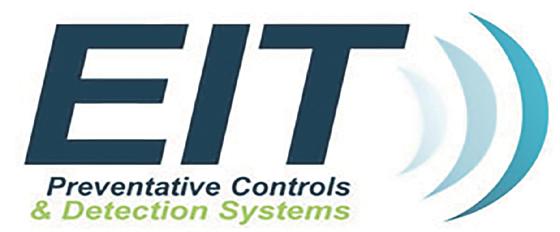


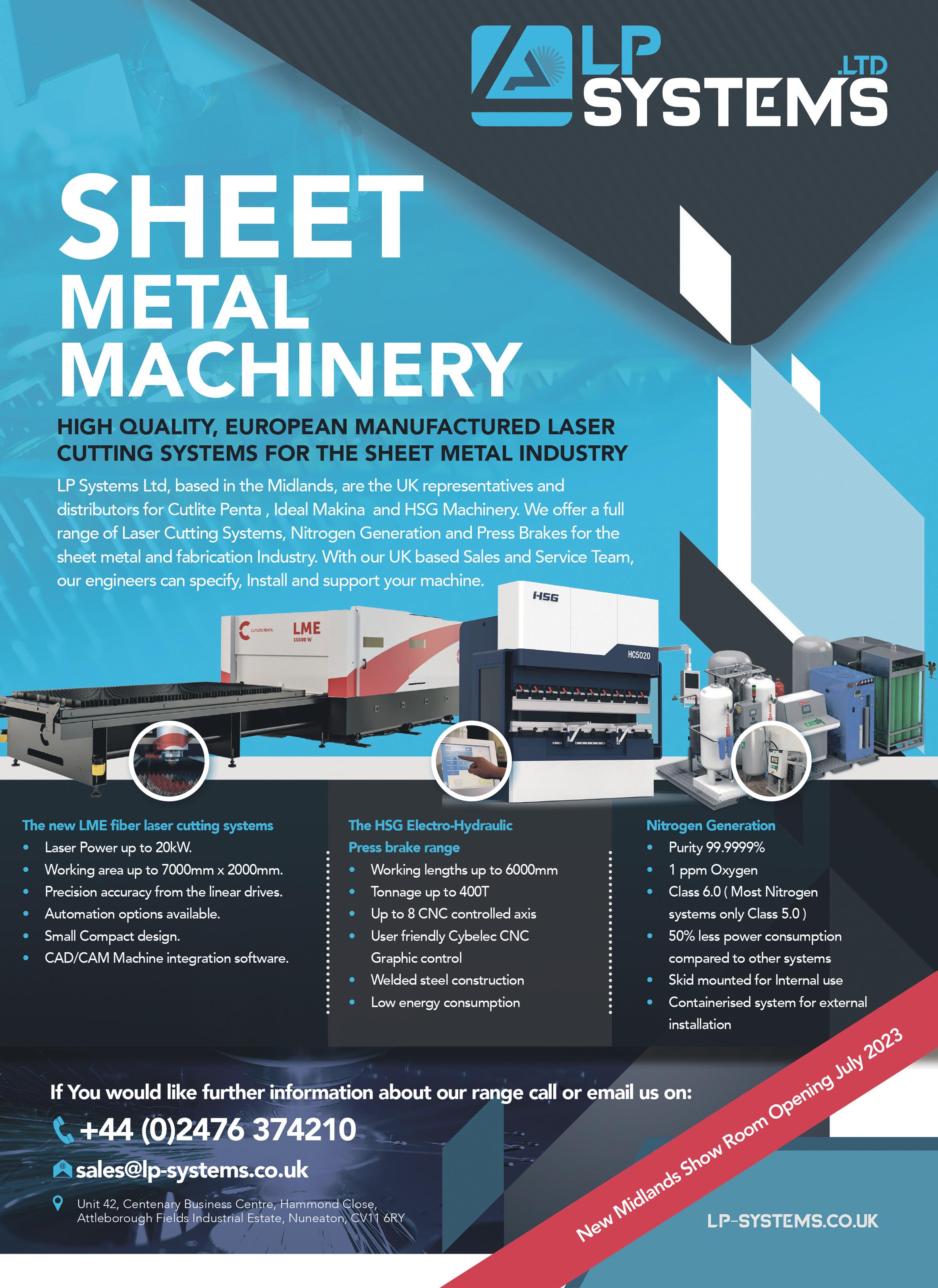
Commitment To Excellence
Excellence in laser cutting and sign making equipment
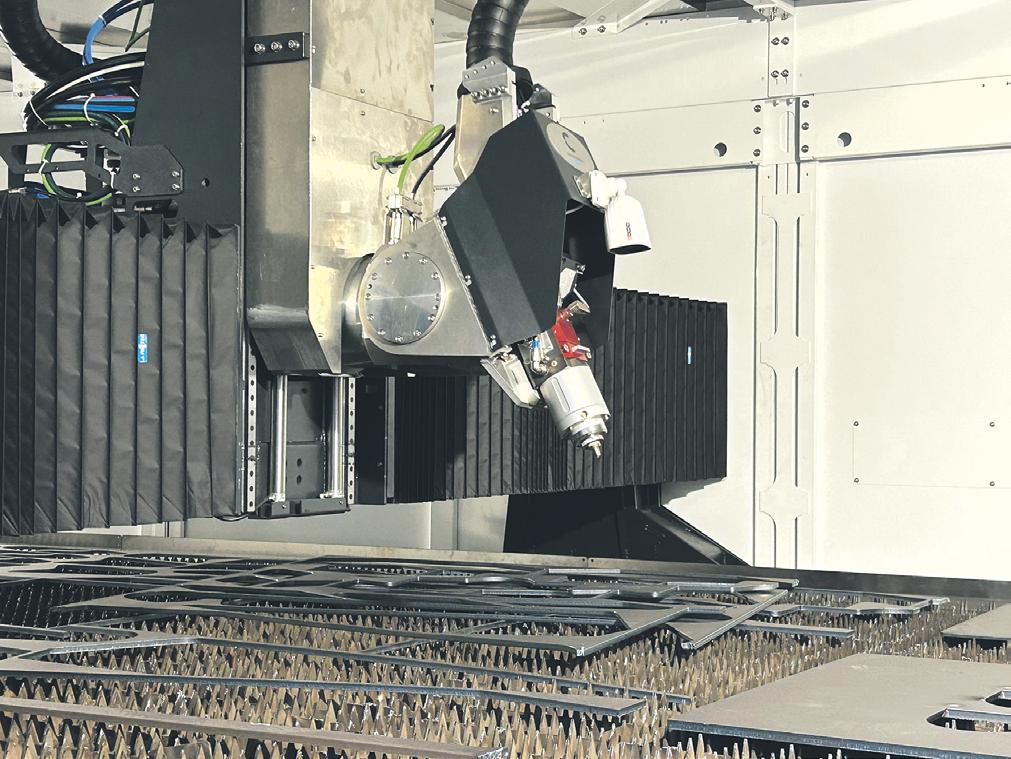
In this issue of Best Practice, we are delighted to award LP Systems with our Commitment to Excellence Award.
LP Systems has been offering a range of laser cutting and sign making equipment for the plastic and sheet metal industry and educational sectors for over a quarter of a century. As the UK representatives and distributors for the Italian Cutlite Penta and Chinese Hans Laser brand, the company is synonymous with quality expertise and offers turnkey packages for customers both in the UK and across mainland Europe.
Based in Attleborough Fields Industrial Estate, near the market town of Nuneaton in Warwickshire, the company has the ideal location for supporting customers all over the country and further afield. The sales and engineering team can offer a bespoke on-site survey, user training, full installation, followed by full after-sales routine servicing and maintenance, optimising the life cycle of the laser cutters and channel bending equipment.
LP Systems are well regarded within the laser cutting and sign making industry, offering expertise and support for all customers, including maintenance support on models bought from elsewhere. We spoke to Richard Eales Managing Director to find out more about the latest, innovative product range:
“Our machines range in both size and power depending on the requirements of our customers and the product in which they are manufacturing. Our lasers which are commonly used in the educational division are up to 130Watts compared to our steel cutting lasers which are up to 40KW.
We are currently manufacturing a laser which has a 12m x 3m cutting area with pallet changer. This will be fitted with a 20KW fibre laser source, a bevel cutting head which will
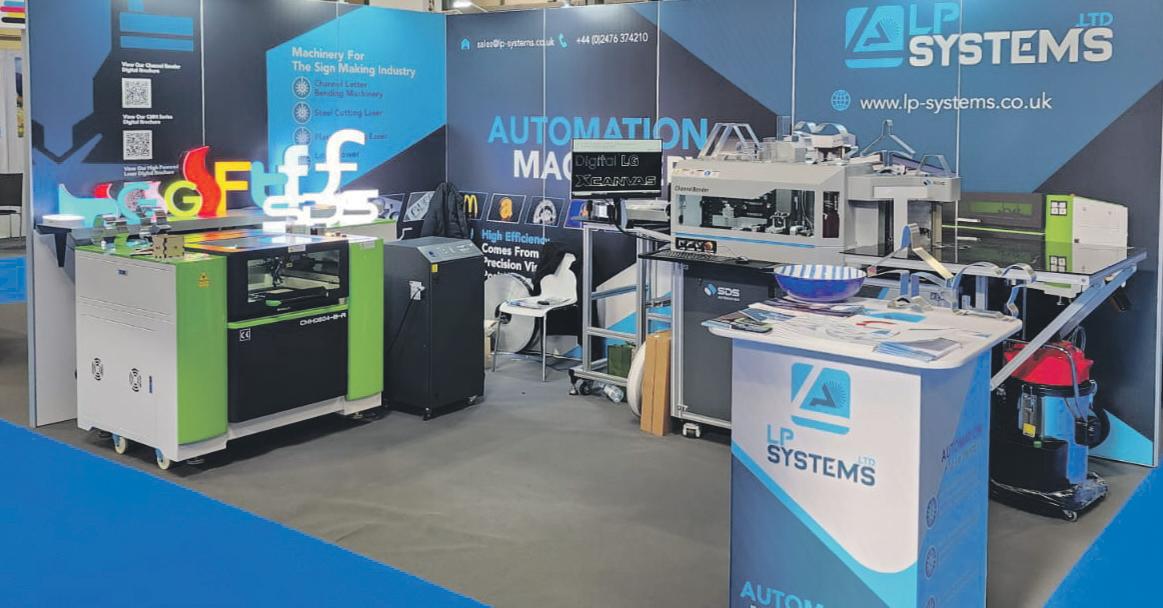
enable the customer to cut on a 45-degree angle, this also makes it easy to add weld prep to the machine. This machine will be used to cut equipment specifically designed for the MOD.”
The existing plastics machines are used extensively across a range of industries from: footwear manufacturing, clothing, home furnishings, 3C digital, advertising, decoration and craft cards. The Hans Laser machines are designed primarily for non-metallic materials such as: wood, leather, acrylic, fabric, paper and plastic, allowing for precise engraving, hollowing and drilling, alongside the laser cutting. With operational speeds up to 500 mm/s, the state-of-the-art machinery offers optimal performance, with meticulous attention to detail, known in the industry as ‘small in size but powerful in function.’
With regards to the education sector, secondary schools are investing more in equipment for popular D&T programmes.


Across the KS3 and KS4 curriculum areas, subjects such as GCSE Construction and D&T are becoming more popular with pupils. LP Systems are ideally placed to offer cutting-edge laser technology to schools, as Richard explains,
“We are currently working with a number of schools to introduce new technology to them in the form of highpowered laser equipment: this will help the schools expand within their DT and Art subjects, we currently have a number of lasers in schools for demonstration purposes.
Furthermore, we are opening our new show room later in 2023, where we can display our catalogue of equipment for potential customers to come and see. This will enable the customers as much time as they require to embrace and test the new technology.”
The laser machines are perfect for a range of National Curriculum projects from children's wooden toys, hybrid plastic/wood mood lighting, clock designs, bird and boxes: providing the next-generation with laser machinery to illuminate their imaginative flair and become the designers of tomorrow.
Whilst some of the education sector is trying on the laser LP Systems technology for size: the plastic and sheet metal industry has been long-standing partners.
With regards to sign-making machines: LP Systems can provide fully automated sign-making operations from hole punching to fast bending. The Channel Bender SXP letter system for channel letter forming has all the characteristics to make traditional face-lit through to hybrid channel letter forming.
Here at Best Practice, we believe LP Systems have shown an unwavering Commitment to Excellence over the last 25 years, culminating in its new 2023 showroom, state-of-the-art education and steel cutting laser machinery and innovative, new laser machine for Ministry of Defence equipment.
Richard Eales and the team were delighted to receive our Commitment to Excellence award,
“We are proud to have achieved the Commitment to Excellence award. We feel this award reflects our hard work over the last 12 months, whilst we have been developing and expanding our business. If we had to use three words to describe our company it would be innovative, knowledgeable and dynamic: a true reflection of our business as we are always looking into the latest technology for our customers.”
To view the product range, see the website below: T 024 76374210 sales@lp-systems.co.uk www.lp-systems.co.uk
Measurably better Chemiluminescence analysers
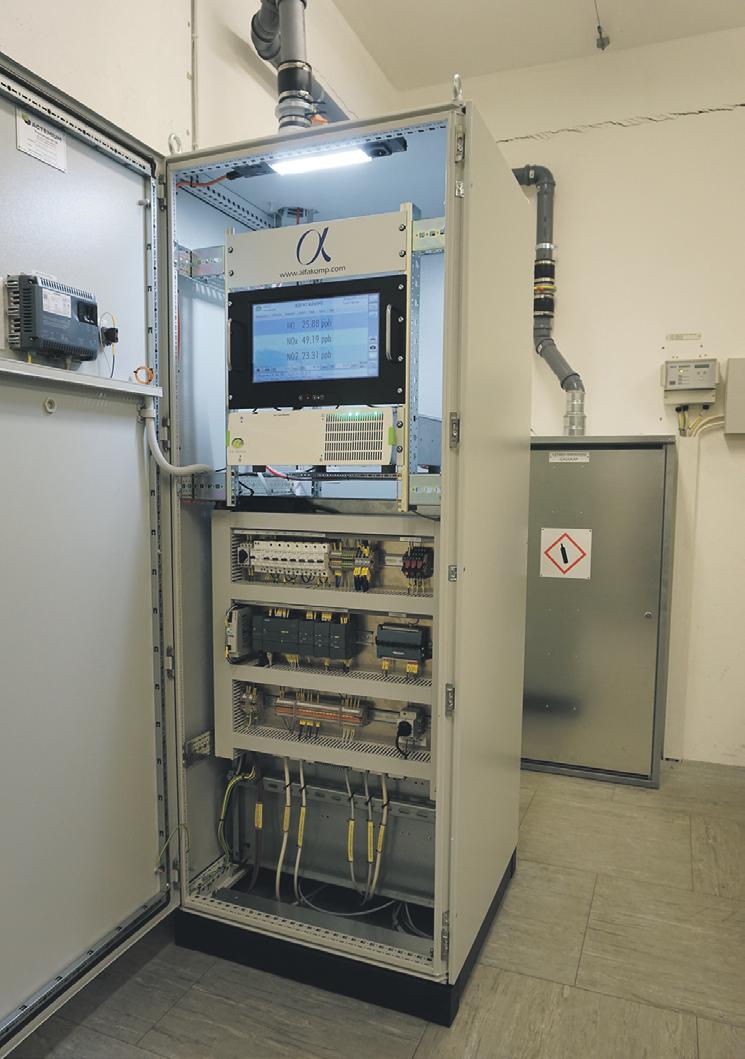
Nitrogen Oxides (NOx) are chief villains in the battle for climate control; belonging to a family of gases that are formed during the combustion of fossil fuels. When Nitric Oxide (NO) reacts with other gases, for example with Ozone, it forms Nitrogen Dioxide (NO2), which is considered highly toxic to human health.
The reaction with Ozone is also an indicator for why Nitric Oxide (NO) is considered a climate active gas, that interacts with Earth’s protective Ozone layer. Human exposure to high levels of Nitrogen Dioxide (NO2), but also Nitric Oxide (NO) can cause airway inflammation, susceptibility to allergens and exacerbate preexisting lung or heart conditions.
Nitric Oxide (NO) is a biological marker of
inflammation and is also produced by cells involved in the inflammation process. It is typically used to diagnose allergic/eosinophilic asthma. Legal ambient air limit value (annual average value for the European Union) for Nitrogen Dioxide (NO2) concentrations is 40 µg/ m³. Maximum occupational exposure1 limit is 950 µg/m³. Indoor air limit value for maximum exposure is 250 µg/m³ but the precautionary value 80 µg/m³. The WHO defines 40 µg/m³ as precaution limit. (https://www.baua.de/EN/ Service/Legislative-texts-and-technical-rules/ Rules/TRGS/TRGS.html).
The Department for Environment, Food & Rural affairs (DEFRA) has also reported soil chemistry and biodiversity changes across many UK habitats, through gas (dry deposition) and precipitation (wet deposition.) Anthropogenic Nitrogen Oxides (NOx) influence tropospheric chemistry, which directly cause photochemical smog and concentrated levels of urban ozone.
ECO PHYSICS AG offer world-leading measurements of Nitrogen Oxide (NOx), through trailblazing chemiluminescence analysers. These innovative analytical solutions are unprecedented in speed and sensitivity, with a cutting-edge range of sensitivities from 1% down to 1 ppt (part per trillion.)
Chemiluminescence Analysers use a unique thermally-stabilised semiconductor photodiode, to measure light intensity produced by reactions between Nitric Oxide (NO) with Ozone (O3). The light intensity correlates to the proportion of Nitric Oxide (NOx) converted to Nitrogen Dioxide (NO2) by the reaction.
We caught up with Dr. Grischa Peter Feuersänger: Head of Sales & Marketing to find out more about ECO PHYSICS, “ECO PHYSICS was founded in 1990 through a management buy-out, by co-founders Dr. Matthias Kutter and Dr. Werner Moser and
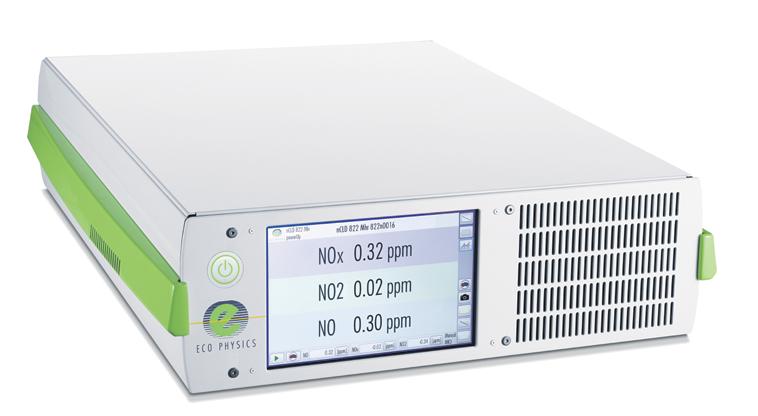
we now operate from our base in Duernten, Switzerland.
We offer innovative analytical solutions for measurement tasks in the fields of environment, health and process control. With our interdisciplinary research and development team, we are delivering customer-oriented and tailor-made products and services. The initial know-how focus was centred on the principle of the chemiluminescence, thus developing and manufacturing analysers for the ambient pollution and emissions.
We have perfected analytical technique in speed and sensitivity. Today we are proud to claim world leadership in the fastest and most sensitive chemiluminescence analysers and the broadest commercially available range.”
This Swiss-based innovative company has EN ISO 9001: 2015 quality management and EN ISO 13485: 2016 medical devices-compliance, offering quality assurance to customers across many industries.
There is a new range of gas analysers and boxed set gas analysers available: nCLD AL, nCLD AL2, nCLD AL3/8555, nCLD EL and nCLD EL2.
The nCLD AL3/8555 is a next-generational modular gas analyser, offering state-of-the-art
simultaneous measurements of NO, NO2, NOx, NH3 and NOX-Amines. Even lower detection limits can be detected through the newly designed reaction chamber, enhanced gas flow paths, improved pressure and temperature stability.
This analyser is adaptable to non-standardised applications, with the unit calibration running smoothly on an automated basis. The digital sensitive graphic user interface allows for increased usability and adjustments can be made quickly and effortlessly.
To see the whole product range, see the website below:
T +41 55 220 22 22 info@ecophysics.com www.ecophysics.com

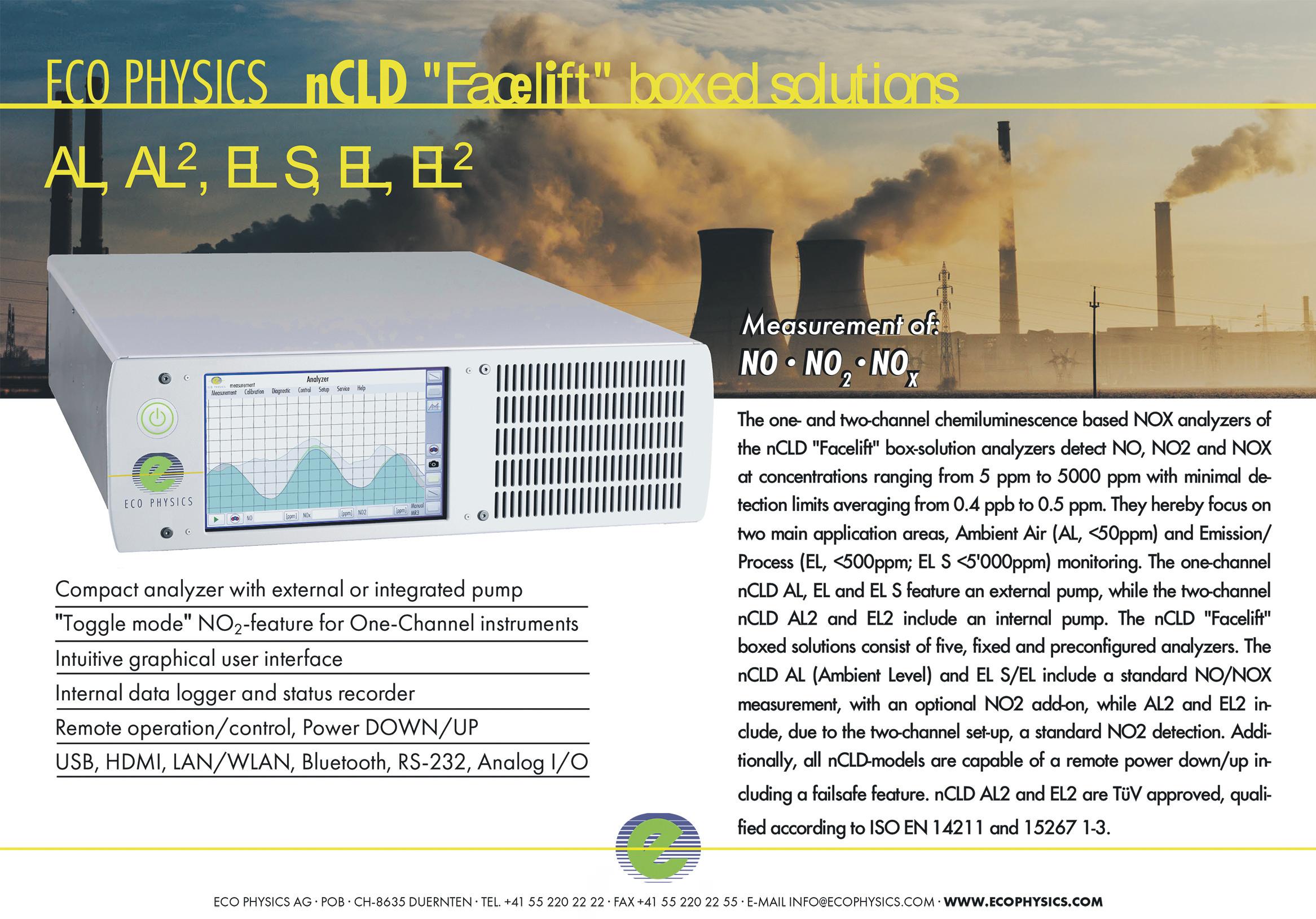
Matara modular aluminium industrial workstations provide adaptable, durable solution
Matara UK Ltd, specialist in automation, pneumatics and linear motion products, is also one of the UK’s leading providers of ergonomically designed Aluminium Industrial Workstations and Workbenches, modular in nature for maximum flexibility.
Matara Industrial Workstations and Workbenches are machined and built in-house, using PG40 40×40 and 40×80 Aluminium extrusion profile, cut to length and pre-drilled ready for assembly. They are available in widths of 1200, 1600 and 2000mm, with all table-top heights at least 900mm from the floor, which can be accustomed using the incorporated adjustable 59Ø feet.
Aluminium extrusion has been chosen by Matara for its range of Workstations and Workbenches as it is corrosion resistant, odourless and impermeable (and therefore non-toxic), making it especially ideal for environments where hygiene is important, such as in food preparation, healthcare settings or hospitality. Hard wearing and long lasting, aluminium is also cost-effective and ultimately a more sustainable material than alternative metals. Sustainability is further enhanced by the modular nature of the Matara Workstations and Workbenches as they can easily be re-purposed or reconfigured to meet the changing needs of a business.
The Workstations and Workbenches have all been ergonomically designed by Matara’s in-house team of design engineers, from the table-top heights to allow for waist height lifting, to the use of vinyl edges for smoothness.
Matara Workbenches are available with or without 24mm grey laminated work top. The Workstations feature a 24mm grey laminated top, optional black MDF, Polycarbonate, or Aluminium Dibond back boards and optional drawers. Up to five drawers can be included, each with a 40kg.max load rating and designed using high-quality runners to ensure a steady and smooth closing action.
Matara Modular Industrial Workbenches are supplied either flat packed (with all brackets and fixings supplied) or can be pre-assembled for a small fee.
Matara modular Aluminium workstations and workbenches are available to buy online from www.matara.com/products/ aluminium-extrusion/workstationsolutions/
Matara is part of Rubix, Europe’s largest supplier of industrial maintenance, repair and overhaul products and services.
For more information, please go to www. matara.com, or contact Matara at sales@ matarauk.co.uk or on 01684 850000.
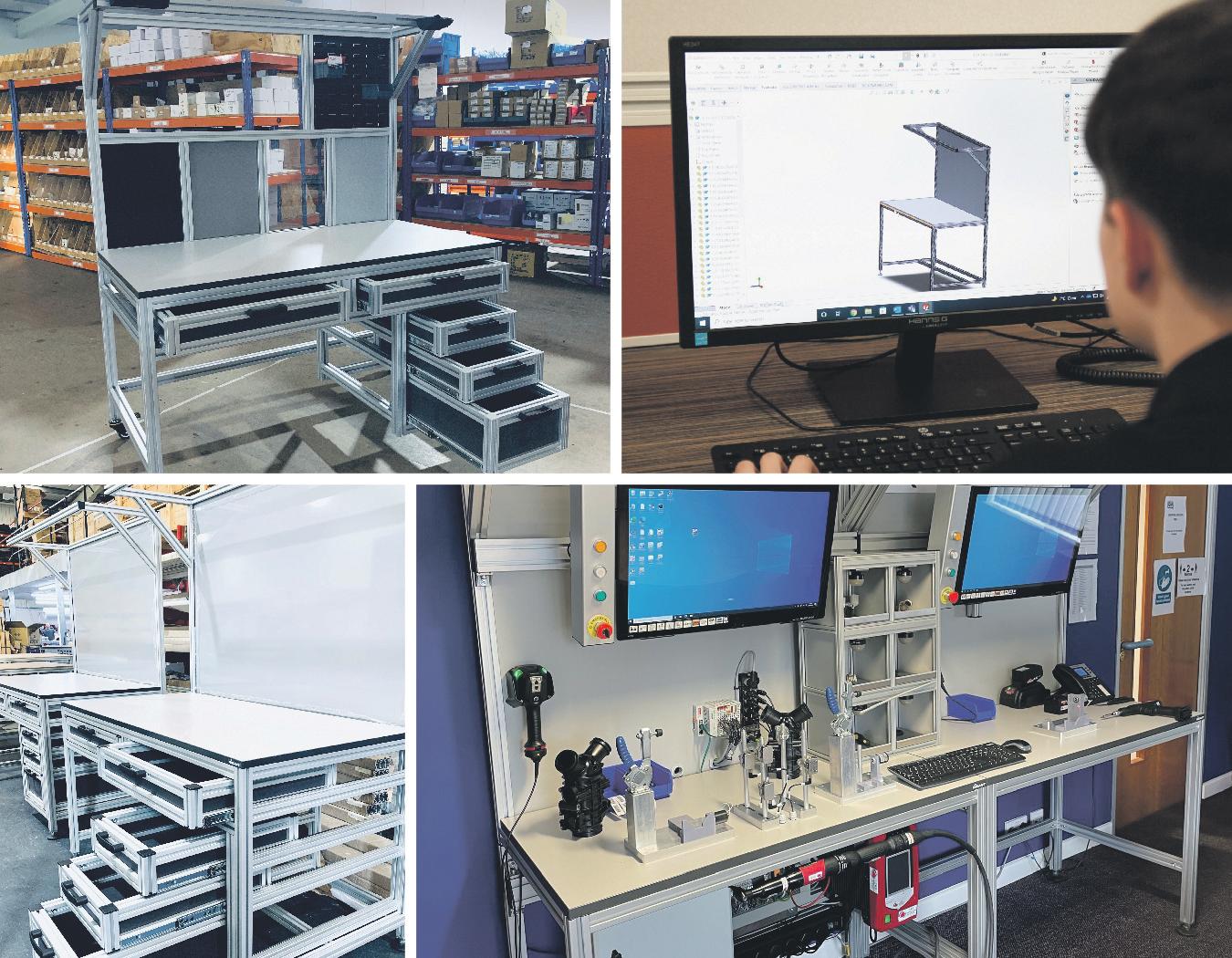
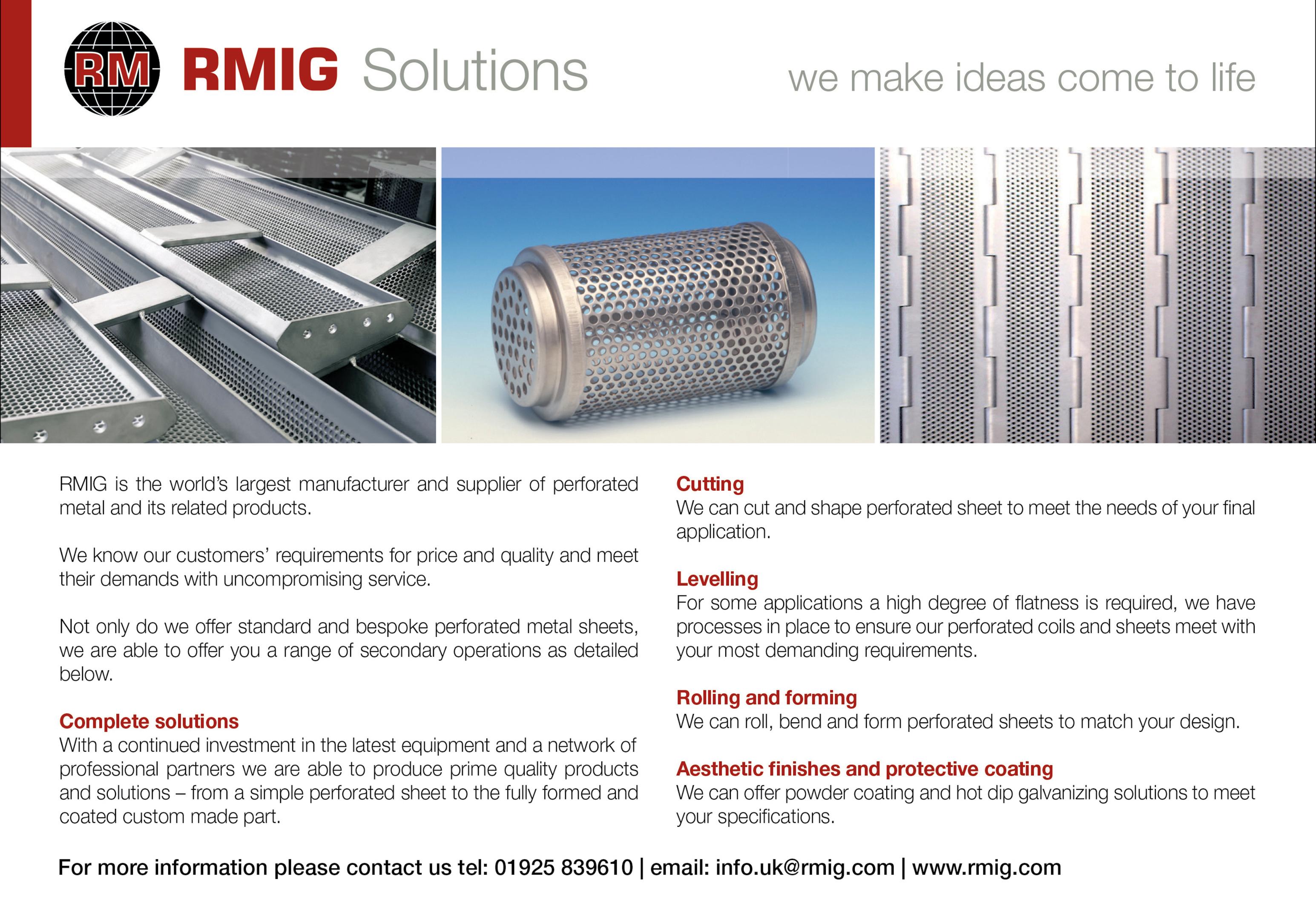
Strand Hardware makes its mark
Strand Hardware has made its mark – completing UKCA compliancy more than a year ahead of the new deadline.
It completed certifications for all its Panic Hardware product ranges – 290 products in total – at the end of last year, in preparation for the original deadline.
The original deadline was intended to be 1 January 2023 but the Government announced an extension as many companies were simply not ready.
The new requirement is compulsory for products which fall within the scope of a ‘harmonised/designated
The future of automation lies with peoplenot processes

Placing people at the heart of automation is key to the future of industry, says Intoware’s Keith Tilley.
Most people will have heard of Industry 4.0 – the powerful concept of using smart technologies such as AI, the cloud, Internet of Things (IoT), wearables and ‘real time’ data.
This use of digital technology to monitor and manage processes is already improving performance, by streamlining critical work processes and collecting and analysing data for better decision making. However – data doesn’t mean a lot without people to use it and in fact, the human element has been somewhat overlooked.
For this reason, the next industrial revolutionIndustry 5.0 – needs to put people back at the heart of industrial production, empowering employees to work in collaboration with technology that has been designed around the way they think and work. The key is to combine people, processes and systems harmoniously.
The move to put people back at the centre of industry ensures engagement and satisfaction with technology, gathering feedback and learning from the processes put in place; the human elements that are often missed.
Digitalising human-centric processes such as reporting and training enables data to be collected and analysed to identify ‘human bottlenecks’ such as gaps in training requirements, different methods used by staff to carry out tasks, and varying recording and reporting techniques, across the workforce.
It also captures and records all the human processes needed to keep things running, such as machine set up, quality assurance inspections, equipment maintenance and repairs, fulfilling compliance requirements more effectively by using photos and video evidence, as well as timestamps and a log of who did each process.
This connectivity between employees and technology reduces inefficiencies and enhances productivity levels, engaging with the workforce to continually improve both workforce and customer satisfaction – something that is vital, yet missed by many companies rushing to digitise critical industrial processes, overlooking the requirements of people at the heart of their businesses.
Visit to find out more: www.intoware.com

standard’ being made available for sale in the UK. They can continue to be CE marked until 30 June 2025 under a 'presumption of conformity'.
Strand Hardware Operations Director Jo Walls said that she was delighted that Strand was fully prepared and had made the transition ahead of schedule.
“We completed our requirements towards the end of last year. We are ready! and have everything in place for the new deadline and have begun to mark our products with the required UKCA markings. Our Declaration of Performance (DOPs), fitting instructions, labelling and certification have all been completed and
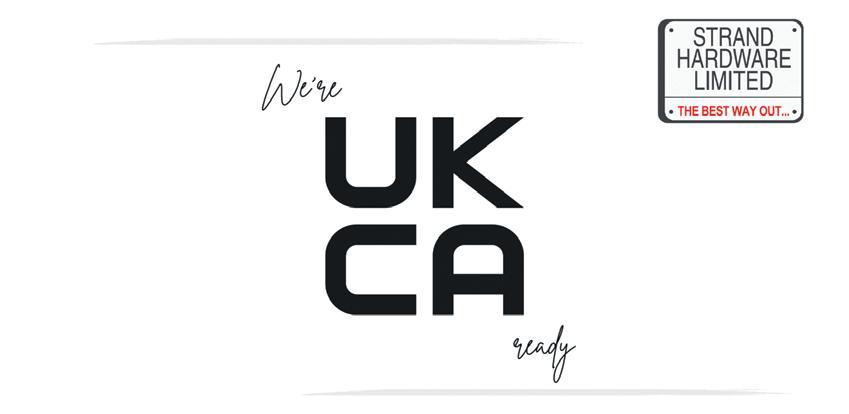
the DoPs are available on our website for download.”
For more information contact: info@strandhardware. co.uk or call: 01922 639111 www.strandhardware.co.uk
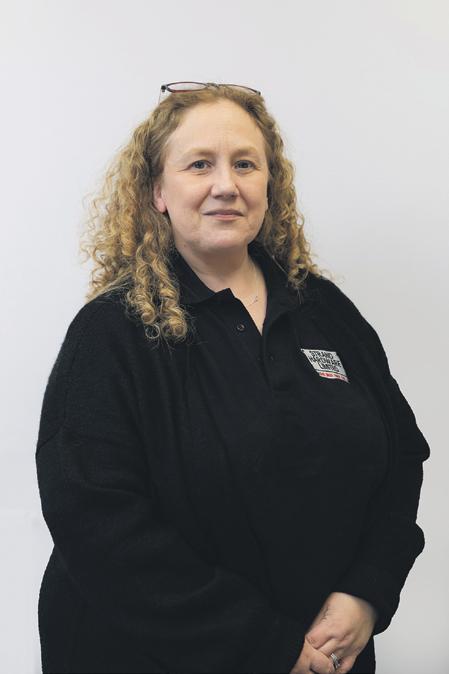

BEPC Encoders
Encoders are indispensable wherever precise measurement and supervision of speed, direction of travel, distance travelled, and position of mechanical elements or number of rotations performed is necessary.
In any case, the encoder invariably affects the proper and efficient functioning of machines and systems. It is therefore a small investment in great profits of enterprises.
BEPC offers two major types of encoders, linear measurement encoders, as the TR1 Tru-TracTM or New Draw Wire Encoder (LCX), and rotary encoders like the Model A58HE which is an EtherCAT or
PROFINET-ready. Linear encoders have a read head and track. This will produce an output for distance travelled typically in pulses per inch (PPI).
Where rotary encoder converts the angular movement of a rotational device and will have an output for rotation about the fixed axis typically in pulses per revolution (PPR).BEPC encoders are increasingly becoming the basic elements of automation systems in industries as:
S Machine building
S Robotics
S Automation and sorting
S Aerospace
S Food & Beverage
S Printing
S Material Handling
S Mobile equipment, etc.
If you still have questions as to how an encoder works in your specific application, please feel free to call a Customer Service Representative for Technical Support.
For more information, see below:
www.encoder.co.uk
sales@encoder.co.uk
01978 262100
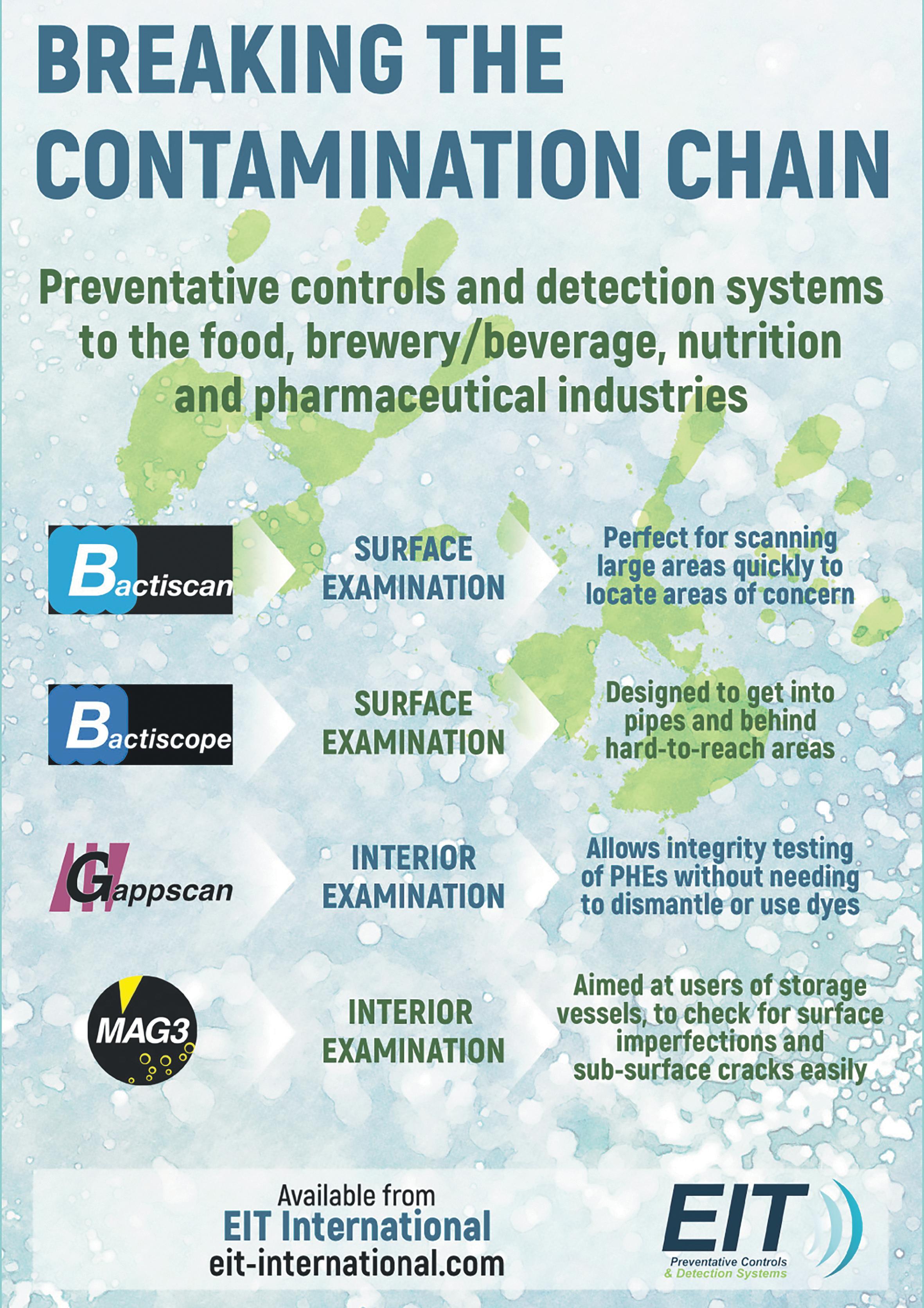
EIT International revolutionises preventative controls and detection systems
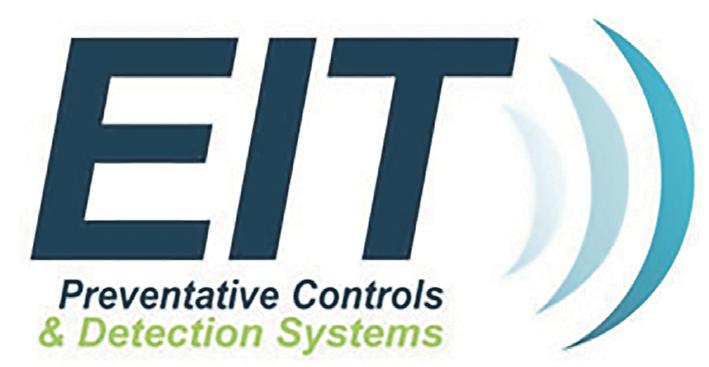
Introducing EIT International - the leading provider of preventative controls and detection systems designed for surface and interior examination in the food, brewery/beverage, nutrition, and pharmaceutical industries. Our proprietary technology allows for an environmentally friendly and non-intrusive approach to GMP, quality adherence, and legislative compliance.
We understand the importance of preventing contamination and ensuring the efficacy of surface cleaning, which is why we offer products like the Bactiscan™ and BactiscanPRO™. These handheld bacteria and biofilm detection systems use wave-alternating UV light to locate surface contamination and can help augment existing cleaning protocols such as ATP. These products are easy to use and make ATP testing more targeted, resulting in more efficient cleaning.
For those hard-to-reach areas like pipework or behind equipment, the Bactiscope™ surface bacteria and biofilm detection system is the ideal solution. With its camera probe and wavealternating UV technology, it can inspect up to 5m and display images immediately. Recordings can also be saved for audit or compliance purposes.
When it comes to interior examination and integrity testing of PHEs, traditional methods can be time-consuming and pose environmental issues with the disposal of chemicals. This is where the Gappscan™ comes in. It uses water and doesn't require dismantling the PHE, making the process quicker and more efficient. It can detect surface imperfections as small as 5µm and can be operated by a single person.
We also offer the Magnerscan MAG3™, which is designed to locate both surface imperfections and sub-surface cracks quickly and easily. This is particularly important in spray dryers where the vessel is working under pressure, and deep cracks may allow contaminants to be sucked in from the exterior of the vessel.
At EIT International, we pride ourselves on our technical expertise in biofilm and bacteria scanners, crack detection scanners, and heat exchanger integrity validation. We can help reduce downtime for preventative maintenance programs and eliminate expensive product recalls. Visit our website at eit-international.com to learn more about our product offerings and how we can help you break the contamination chain in your industry.
www.eit-international.com
Hygiene trio join forces
Danish food hygiene equipment expert joins forces with Warrington hygiene solution provider Christeyns Food Hygiene and application partner H&M Disinfection Systems Ltd, to offer unique turnkey solution.
The leading family-owned supplier of detergents and disinfectants, Christeyns Food Hygiene, has joined forces in a tri-partner initiative with specialist producers of world-renowned equipment manufacturer Foamico and hygiene equipment specialists H&M Disinfection.
This partnership provides the confidence that hygiene operations need to deliver world-class
Christeyns Food Hygiene steps up support for dairy industry
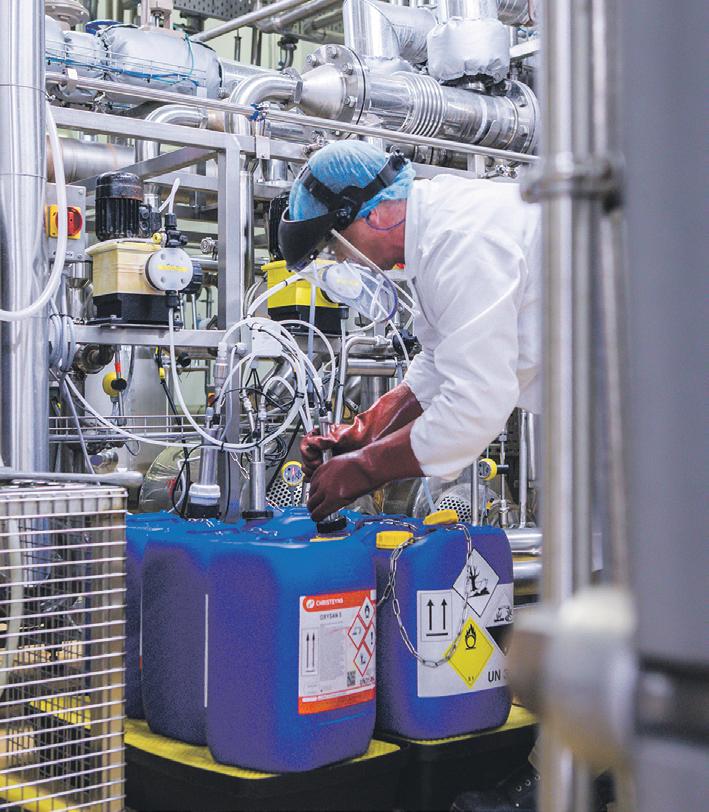
The UK is the thirteenth largest milk producer in the world, with milk accounting for 16.4% of total agricultural output in the UK in 2020.* 15.3bn litres were produced in 2020, worth £4.4 billion in market prices. Maintaining high standards of hygiene is crucial to continue the integrity of the sector and protect the income it provides for farmers and the dairy industry in general.
In recognition of the importance hygiene plays in the success of the UK dairy industry, Christeyns Food Hygiene is a key sponsor at this year’s International Cheese & Dairy Awards. The awards, now in their 127th year, continue the celebration of cheese and dairy and bring together passionate people from all over the world in one location. They are the oldest awards of their type in the world.
Warrington-based Christeyns Food Hygiene is one of the UK’s leading suppliers of hygiene products, expertise and support providing a cost effective, dedicated range of detergents and disinfectants specifically formulated to meet the needs of the dairy and cheese industry. Over the years Christeyns Food Hygiene has developed specialist detergents to clean delicate membranes enabling them to achieve their maximum flux rates and QAC-free disinfectant products to ensure that current legislation can be successfully complied with.
Optimisation, verification and validation of Cleaning In Place regimes is also an important part of daily cleaning where software packages such as Insite-CIP constantly monitor and verify the efficacy of the CIP regime on each and every clean. This ensures the highest level of food safety is achieved alongside compliance with third party standards.
“Increasing our support of the ICDA is both an honour and a privilege,” comments CFH UK Technical Director, Peter Littleton. “We have supported the cheese & dairy sector for over 34 years and have been involved with both the trade show and the public event, previously at Nantwich and now at the Staffordshire Showground, over all this time. The extension of the Love Cheese Live event will reach out to an even larger audience this year, showcasing the very best this diverse sector has to offer.” www.christeyenes.com
cleaning in the demanding food, dairy and beverage industries from design and supply to effective cleaning and disinfection.
For over 30 years Christeyns Food Hygiene has produced effective formulations of detergents and disinfectants for all applications in the food, dairy and beverage industries with customers from across a range of household consumer brands and suppliers to the UK’s food retailers. As part of family-owned Belgium parent company, Christeyns NV, the firm draws on the expertise and knowledge of a multinational team of experts.
Foamico is an independent manufacturer of
superior cleaning solutions in the food, dairy and beverage industries. Its core business is to develop, manufacture and deliver reliable and efficient cleaning solutions for surface and open plant cleaning worldwide. Operating in 50 countries, Foamico’s key focus in on food safety with a reputation for innovation and reliability.
Having worked with CFH for three decades, H&M Disinfection Ltd have built a reputation for providing high quality, bespoke hygiene application equipment which is the cornerstone of many customer’s food safety management systems. The partnership was formalised last year to provide customers with a more stream-lined service in the provision of top-

quality formulations and equipment. chemicals required to achieve food safety coupled with the equipment critical to delivering those products to the food contact surface.
www.christeynes.com
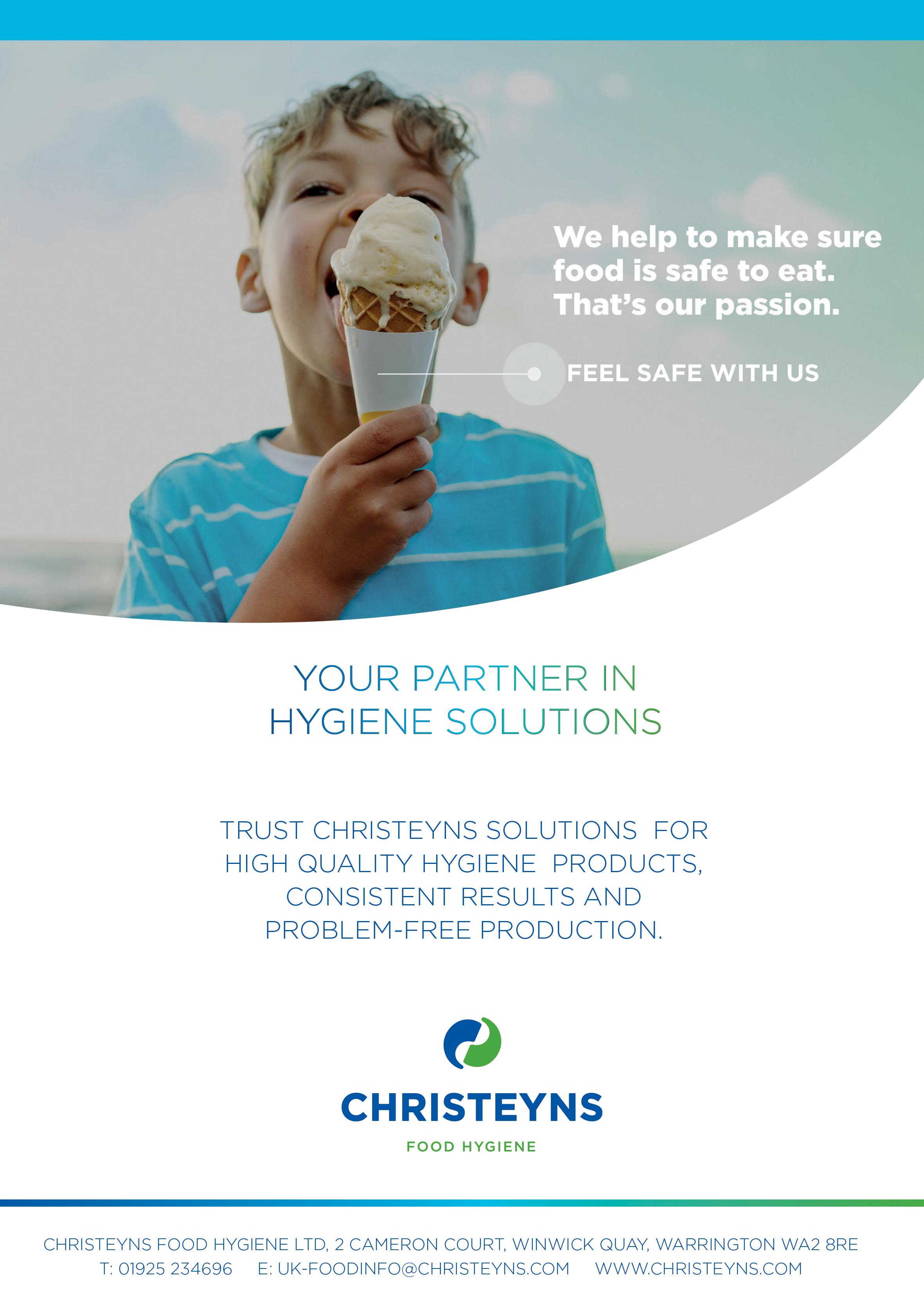
Bona releases 2022 Sustainability Report
Highlights include increased use of postconsumer recycled plastic, waste reduction at its facilities, and new sub-vision to reduce environmental impact and be carbon neutral by 2040
Malmo, Sweden. March 27, 2023 – Bona®, a global, sustainably-driven company that supplies products for installing, renovating, maintaining, and restoring premium floors, today released its 2022 Sustainability Report which highlights the company’s sustainability vision to “lead the sustainability transformation of our industry, caring for people and planet.” In line with the new
vision are sub-visions based on the company’s approach to its sustainability work which is rooted in three pillars - Home, Health, Humanity.
“Bona’s sustainability journey began with our founders and over the years we have reached several notable milestones in our efforts to drive sustainability within the industry,” said Magnus Andersson, Bona CEO. “With our new vision, we take another step on our journey by reinforcing Bona’s business model of encouraging floor renovation and maintenance over replacement, which saves energy consumption and reduces the climate footprint.”
Each pillar of the company’s sustainability approach represents how Bona can most affect change. This year, Bona established sub-visions that align with each pillar:
S Home: Reducing our environmental impact, being carbon neutral by 2040
S Health: Business growth through healthy and innovative choices
S Humanity: Fair and equal opportunities for our employees and supply chain
Bona’s sustainability vision functions as a starting point of a broader sustainability agenda, whereby

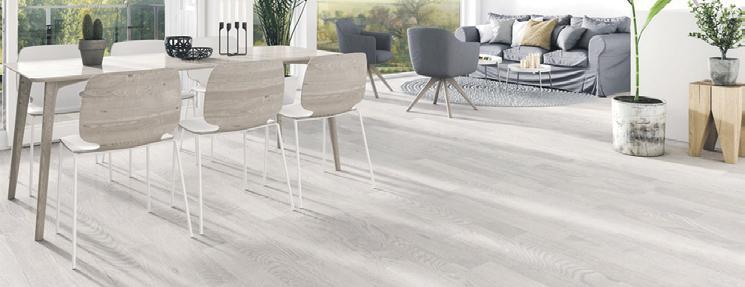
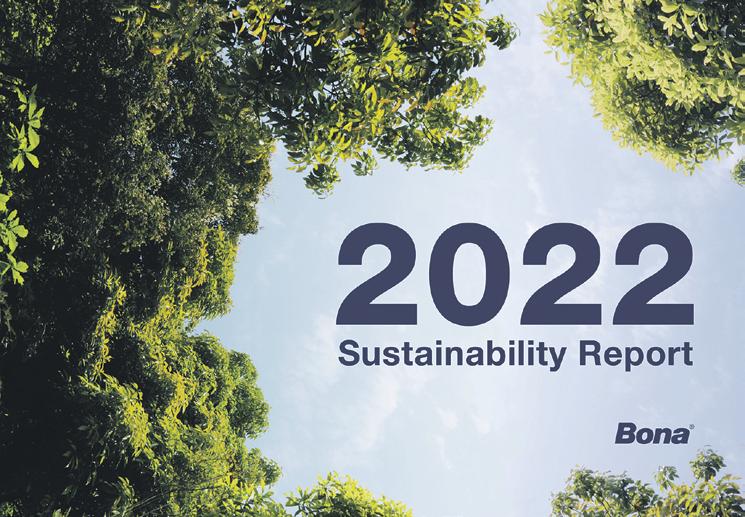

Bona will be measuring and monitoring its sustainability performance more thoroughly.
In keeping with this, the Bona Sustainability Report 2022 is the result of efforts made by Bona to re-shape its sustainability work in response to the Corporate Sustainability Reporting Directive (CSRD). In the report, Bona presents information about its strategy, goals, initiatives, and performance in a manner well-suited to the needs and interests of its stakeholders.
Andersson continued, “We welcome the ambitious developments by the EU to increase transparency and accountability within corporate sustainability. While it will take time to address the demands by the CSRD, this year’s report is a step in the right direction. By raising the standard for how we operate and present our performance, I believe we send an important signal that we are making progress.”
In addition to the new vision and subvisions, highlights of the 2022 Sustainability Report include the addition of Position Green to better understand and manage the company’s sustainability progress, a new corporate partnership with WeForest to help restore forests in Brazil, and increased energy efficiencies at its sites in Germany and Sweden. The report also profiles the 2022 E.P.A. Safer Choice Partner of the Year Award and a drive to increase post-consumer recycled plastic in its packaging.
The Bona Sustainability Report 2022 is available for download via the company’s web site, www.bona.com/sustainability2023.
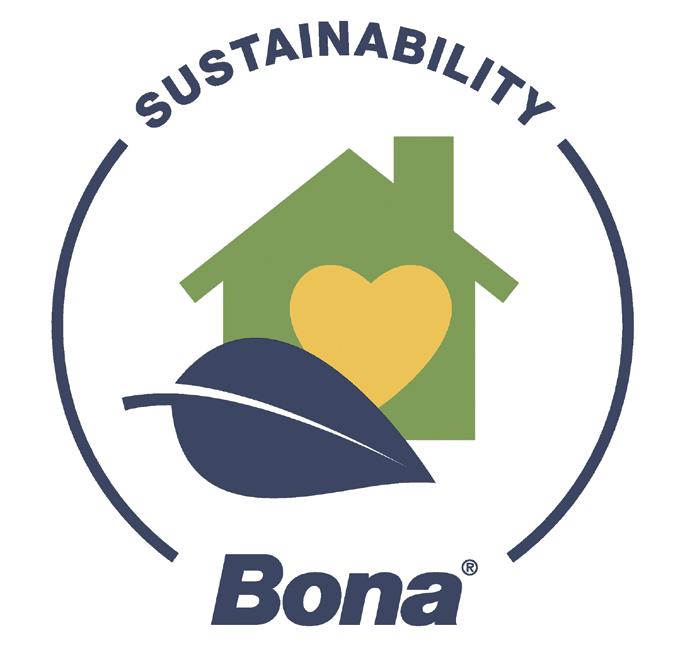
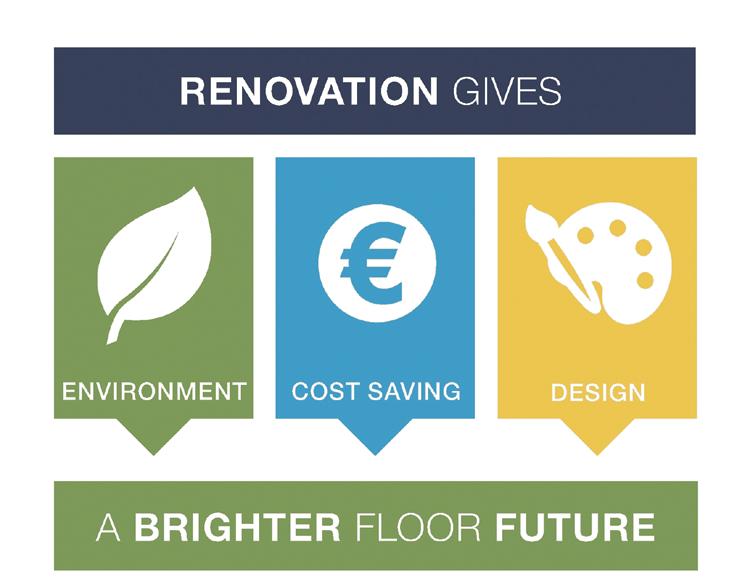
Pumps & Valves
Oliver Valves progress order for Marjan Project
Oliver Valves, working in collaboration with its sister company Oliver Twinsafe has reached phase two of production to fulfil a significant £7 million pound order to supply the Marjan Oil Field Development in the Arabian Gulf.
Since 2021, Oliver’s have been working closely with a major EPC contractor in the middle east region to deliver a range of valves for the Marjan project which is owned and operated by Saudi Arabia’s state-owned oil and gas company, Saudi Aramco. The oil field development has undergone huge expansion to increase production capacity for crude, ethane and natural gas liquids.
This offshore expansion forms part of Saudi Aramco’s $18bn investment programme in the region and includes; tie-in
Pneumatic Diaphragm Pumps

Pneumatic Diaphragm Pumps are the most versatile pumps ever built. Even though these AODD pumps offer quite a few advantages over the electric operated pump technologies, there has not been a radical change or evolution in the basic design over years and almost every diaphragm pump had similar issues and problems.
SAMOA® – A European pump manufacturer, established in 1965, has been in the forefront of developing innovative air operated pump technologies over the last six decades. For the first time in the industry, SAMOA® has developed an Air Operated Diaphragm Pump featuring a globally patented, virtually wear-free, frictionless pivoting air valve eliminating most of the issues users face today.
Conventional Air Operated Diaphragm Pumps
S High energy consumption
S High pulsation and heavy vibration
S
S
S
S
S
S
S
SAMOA® Air Operated Diaphragm Pumps
S Significant energy savings up to 75%
S Offers smooth flow with reduced vibration
S Reduced noise
S Up to 4x longer life
S Can handle clean, dry, damp or even dirty air
S Stall-free and ice-free
S Air valve maintenance taking less than 5 minutes
S Remote monitoring and controlling capability
S Best total cost of ownership
www.samoaflow.co.uk
platforms, production decks, subsea export and infield pipelines. Oliver’s second phase delivers on a large number of 2” Trunnion Double Block and Bleed Ball Valves that have been designed and tested to API 6A standard and are to be supplied to multiple Tiein and Wellhead Platforms.
Valve production and testing is expected to be completed by January 2023.
To find out how Oliver Valves and Oliver Twinsafe can meet your valve requirements, contact us by telephone +44 (0)1565 632 636. sales@valves.co.uk www.valves.co.uk
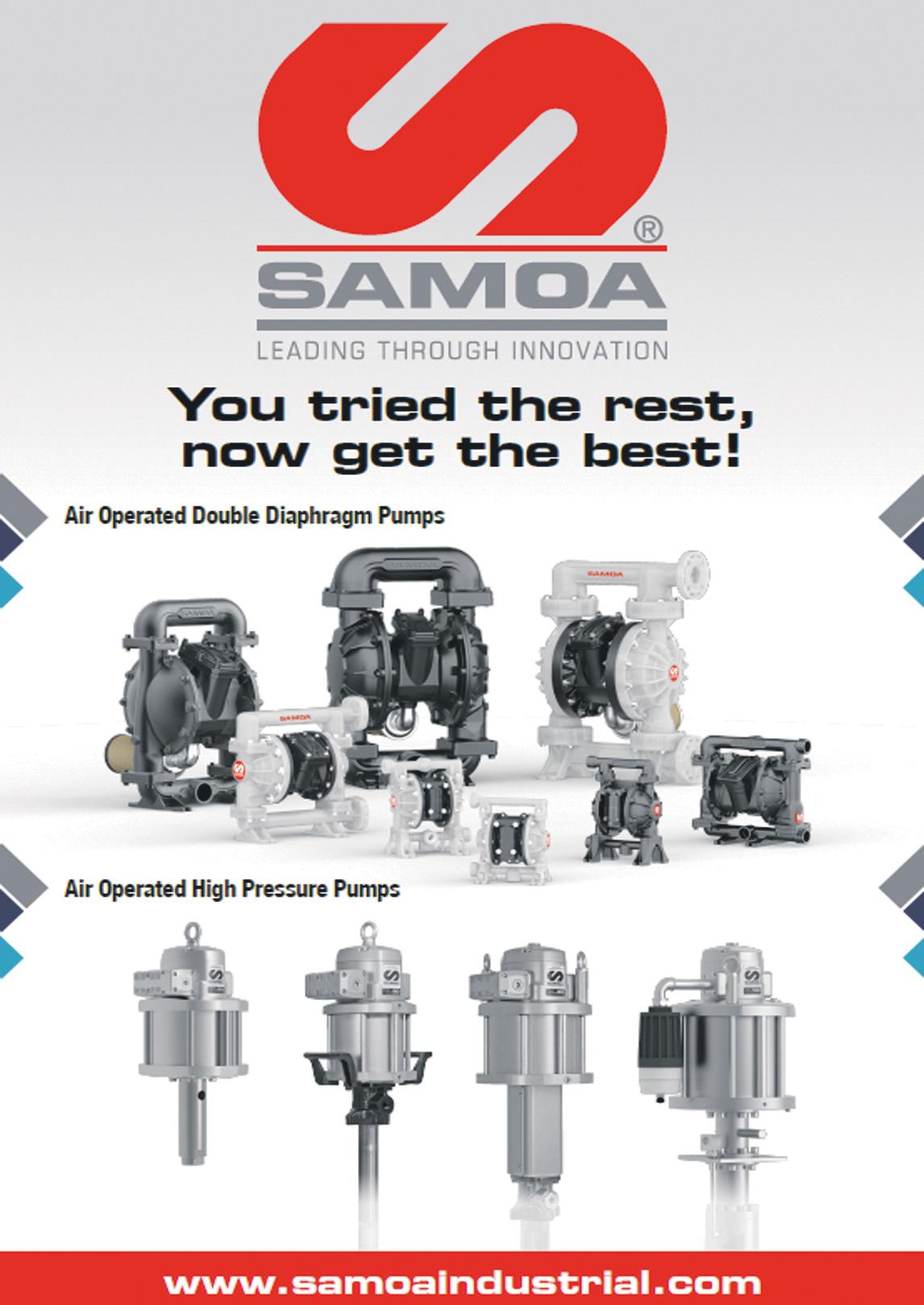
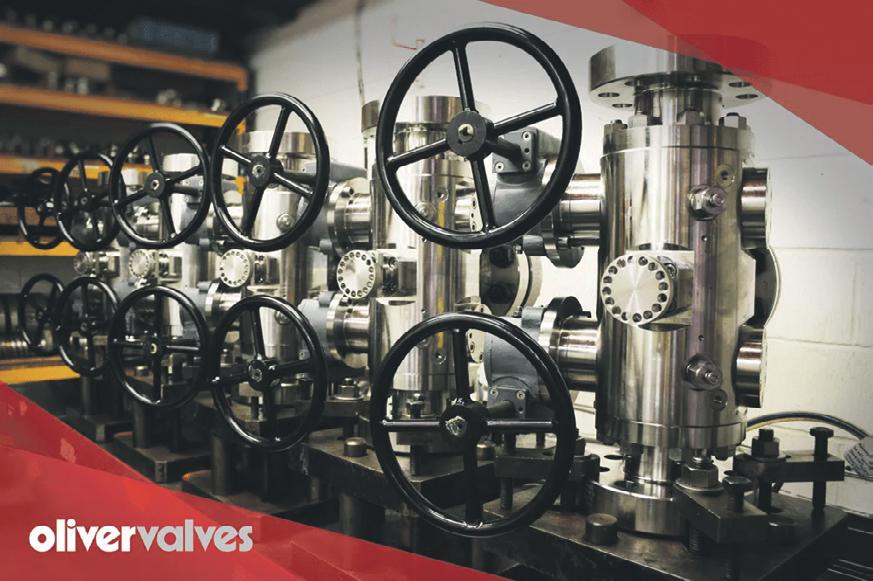
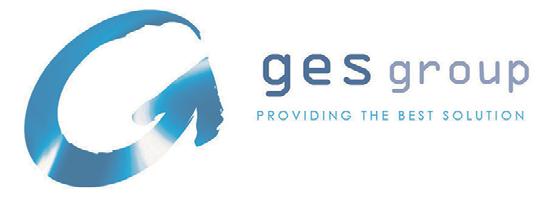




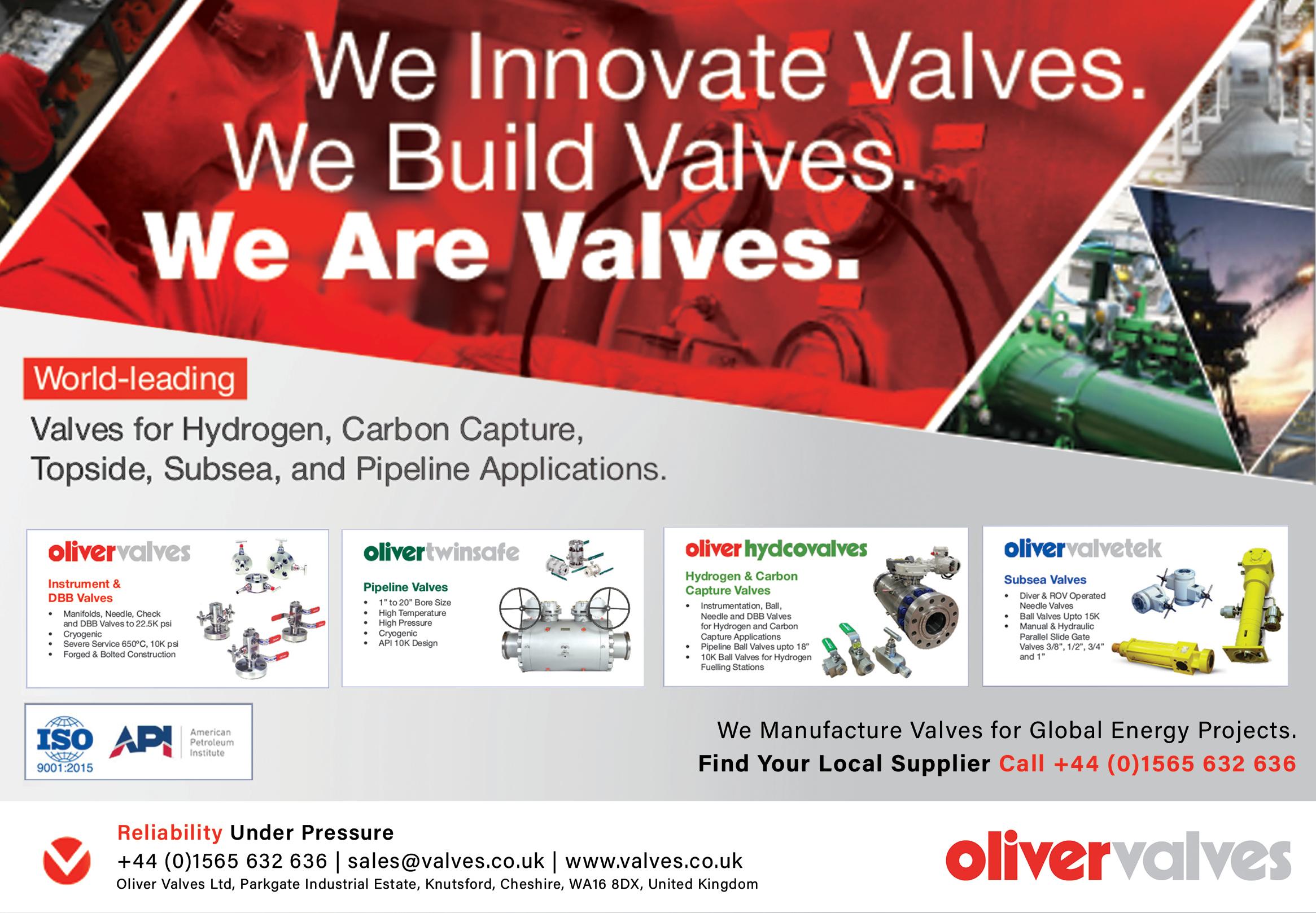
Leading the way in recyclable pump technology

The first Quantex pump was invented by Quantex Founder, Dr Paul Pankhurst, to create a less expensive, more accurate alternative to a peristaltic pump. Several years of R&D and customer collaborations, led to the successful development of several off-the-shelf, recyclable pumps with varying flow-rate ranges. In June 2021, Quantex was acquired by PSG, an operating company of Dover Corporation and now sits alongside 13 other pump and flow measurement brands.
Since the acquisition, Quantex has moved its headquarters to Duisburg, Germany where it benefits from the established resources and clean room facilities already in place for other PSG brands: Quattroflow, Almatec, and Hydro. Quantex’s London office and dedicated manufacturing plant in High Wycombe are still in operation.
“Quantex is the leading provider of recyclable pump technology, where, instead of the pump being a part of the fixed equipment, it

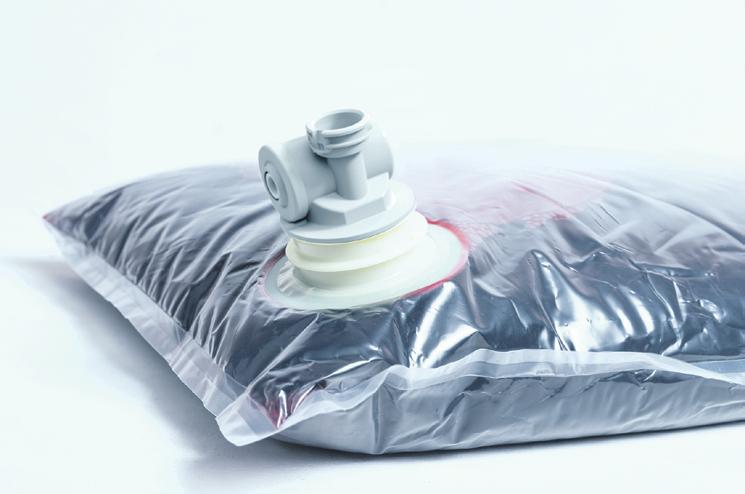
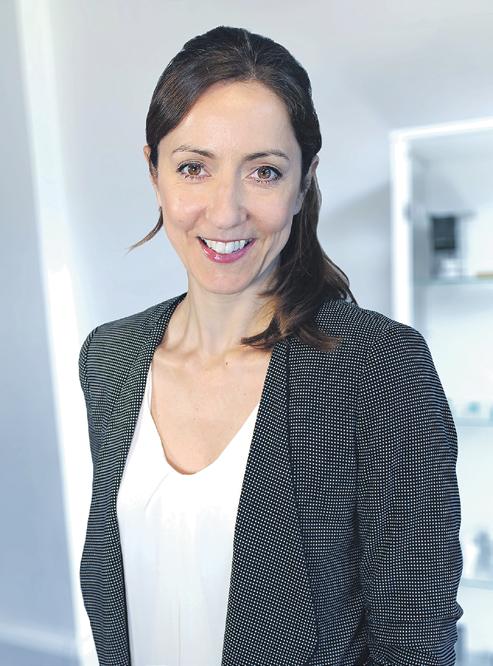
is attached directly to the liquid packaging – similar to the way a tap is already connected to a bag in box of wine. But instead of pressing the tap and allowing liquid to dribble out using gravity, the pump is clipped into a motor drive in the fixed equipment, and the product is dispensed accurately, at a range of precision flow rates suitable for all kinds of liquids. When the product supply is finished, you simply replace the bag and pump with a new bag and pump,” stated Gillian HardingMoore, Director – Marketing.
Quantex’s system is extremely hygienic and requires no costly cleaning or maintenance. The Quantex pumps also maintain vacuum capability which equips them with the ability to handle high viscosities such as mayonnaise, hair conditioner, or glue, and can evacuate the bag by 98%.
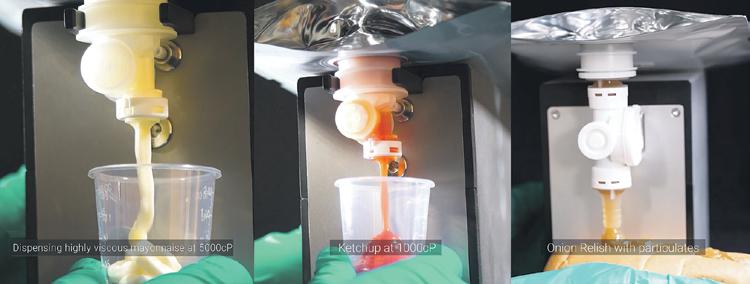
“The pumps can also reverse cycle which is widely used for cleaning the nozzle at the end of each dispense by sucking the product back into the pump. Another very exciting capability is its in-pump dilution option, where it can pump high-ratio concentrates, and accurately mix them with water at the point of dispense. This takes water out of the distribution channel, saving the customer both money and carbon emissions from shipping their products around the world,” added Gillian.
With the drive to save single-use plastic waste, the wealth of benefits of using Quantex pumps has been recognised by UK and European supermarkets, who have been attempting to trial refill stations, where consumers bring their reusable bottles to refill in stores instead of using single use pre-packaged goods. Dispensing liquids has been proving to be too expensive and labour intensive for shop-floor staff.
“Quantex technology provides the key enabler for scaling up refill in supermarkets, with a low maintenance, low cost and flexible solution that can be standardised for dispensing virtually any fluid. Quantex is working with several refill equipment manufacturers,
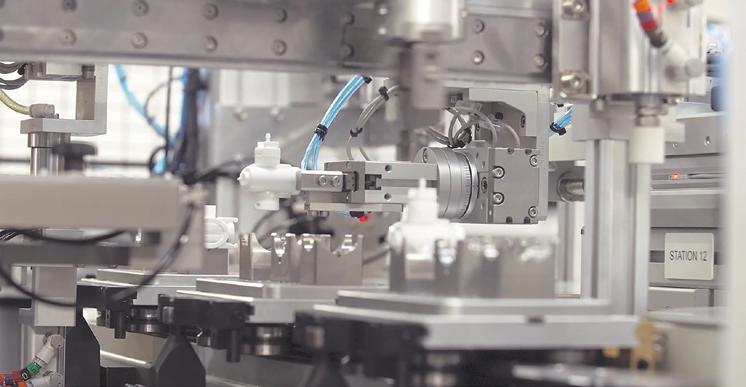

who are designing their next generation of dispensers around the Quantex system.” Gillian continued, “Several global brands and retailers are excited by the early prototypes that allows product replenishment to be 75% faster, with no cleaning or maintenance, and no drips that cause dangerous slip hazards in supermarket isles. The aim is to provide a better refill experience for consumers and therefore, encourage more refill adoption. The first machines are planned to be in European supermarket trials in 2023. It is an exciting market to be in, as it is just the beginning of a big change to the way we shop, and Quantex is sitting at the heart of the movement.”
As the company looks ahead, in addition to Refill, Quantex is moving into the Biopharma market, and aligning with other Dover brands; Quattroflow®, em-tec, Malema®, and CPC® Gillian added, “The alignment will strengthen our PSG offering, providing pumps, flow measurement solutions and connectors that serve cell and gene therapy and bioprocessing needs from early process development through to upstream and downstream applications.”
T +49 (2065) 89205-0
www.quantex-arc.com
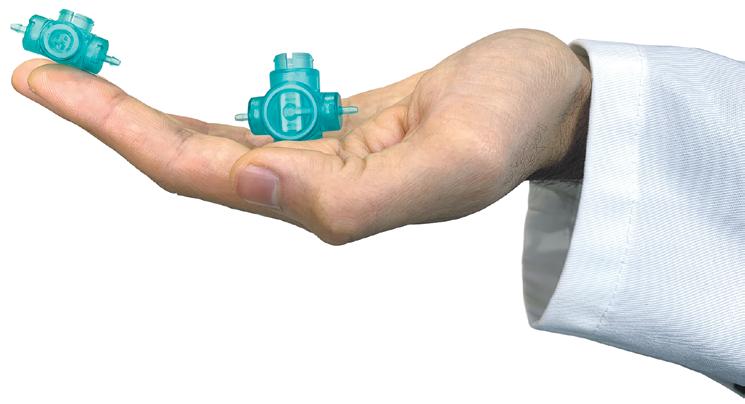
Cleaning
Choosing an “Industrial Vacuum Cleaner”
The vacuum cleaner market is vast and the number of different machines available is immense giving a potential customer a dilemma when trying to choose a machine to solve a particular problem. The machines available range from the cheapest units manufactured from the thinnest and flimsiest materials and churned out on production lines in various parts of the world, to small production, specialist machines manufactured to satisfy the most demanding requirements.
BVC (the original British Vacuum Cleaners) is a brand manufactured by Quirepace Ltd very much in the latter category; just as there is always a market for traditional, specialist cars, discerning customers for Industrial Vacuum Cleaners will undoubtedly find a solution within the BVC range.
With the exception of a small range of budget units (the BVC Greenline range) targeted at light duty applications, BVC Industrial Vacuum Cleaners are manufactured in the UK from predominantly UK sourced components. Quirepace operate their own press shop for many of the metal pressings used in production, and components such as fabrications and castings are sourced from local specialist suppliers.
UK manufacture means that Quirepace are not only able to keep very close control of the whole process from design to delivery, it also means that every machine in the BVC Industrial Vacuum Cleaner range can be manufactured to the customers specification.
In the world of industrial processing, materials to be cleaned are inevitably incredibly diverse; some products are hazardous to health if breathed in in significant quantities, some are potentially explosive and require ATEX rated equipment. Other materials might be heavy (eg. aggregates) or abrasive, or sticky, or wet. Whatever the application there will most likely be an appropriate BVC
machine available.
It is difficult to pick an Industrial Vacuum Cleaner at random & hope that it is suitable. Sometimes people compare machines by their maximum flow rate, or perhaps maximum vacuum, without realising that these are a very poor guide to real-world performance. Maximum vacuum is measured with zero flow, and maximum flow with zero (or little) vacuum, and hence these figures do not give a reliable indication of actual performance. Quirepace’s specialist sales team offer onsite demonstrations at the customer’s premises so that performance can be evaluated.
Selecting an Industrial Vacuum Cleaner isn’t just about the machine itself. There will be choices to be made in the type of filter to be used and the tools and hoses required to attach to the vacuum unit. BVC Industrial Vacuum Cleaners are all available with several choices of filter material. Apart from standard microfibre bag filters, Quirepace offer ‘Clearflow’ filters; a special design with a huge surface area which helps to maintain flow without blinding, PTFE coated materials for sticky products, fire-resistant materials, anti-static materials for ATEX applications and of course various standards of HEPA filters for hazardous dusts.
Industrial Vacuum Cleaners require Industrial Tools. Many tools in the BVC range are heavy duty metal castings and fabrications designed for long life in an aggressive industrial environment. High quality tooling ensures that the performance of the Industrial Vacuum Cleaner gets to where it is needed reliably time after time for many years. For those tools that have wear parts – like the rubber strips on the heavy duty height adjustable floor tools, of course Quirepace have local stocks of spare parts.
The BVC range from Quirepace offers heavy duty, durable and reliable Industrial Vacuum Cleaners for
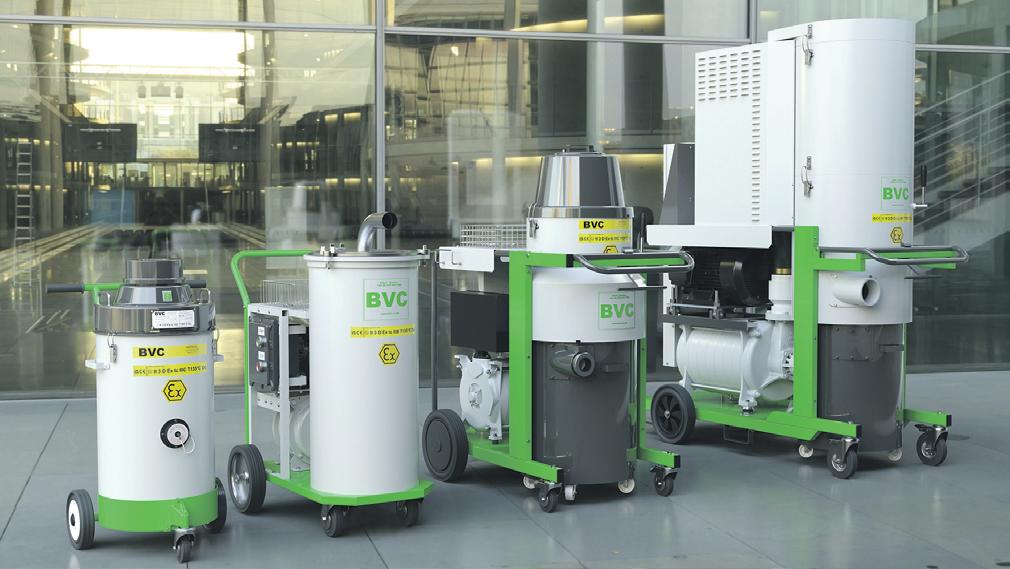

all applications, backed up by a knowledgeable and experienced sales team and an extensive service and parts department.
Contact Quirepace to discuss your requirements: T 023 9260 3700
BVCsales@quirepace.co.uk www.quirepace.co.uk
Medical shops achieve surgical precision with deep hole drilling automation
Medically speaking, cutting people open is dangerous. Today, physicians get around this problem by using modern surgical instruments to perform minimally invasive procedures, which make major operations into simple outpatient appointments. But to accomplish these feats of surgical science, manufacturers in the medical industry have to drill small-diameter holes through the entire length of slightly larger instruments. Thin part walls, intricate features, high surface quality and concentricity requirements, and extreme depth-to-diameter (D:d) ratios make these parts a challenge in production.
A typical laparoscopic surgical instrument is designed to direct tools, cameras and other devices into the body through the instrument using a guide wire. And to ensure smooth, reliable and accurate performance during procedures, highly precise hole concentricity is required at D:d depth ratios well above 100:1, a challenge even for dedicated deep hole drilling equipment.
With these challenges, it’s no surprise that many manufacturers try to skip the deep hole drilling process altogether by farming out the work, but going to outside
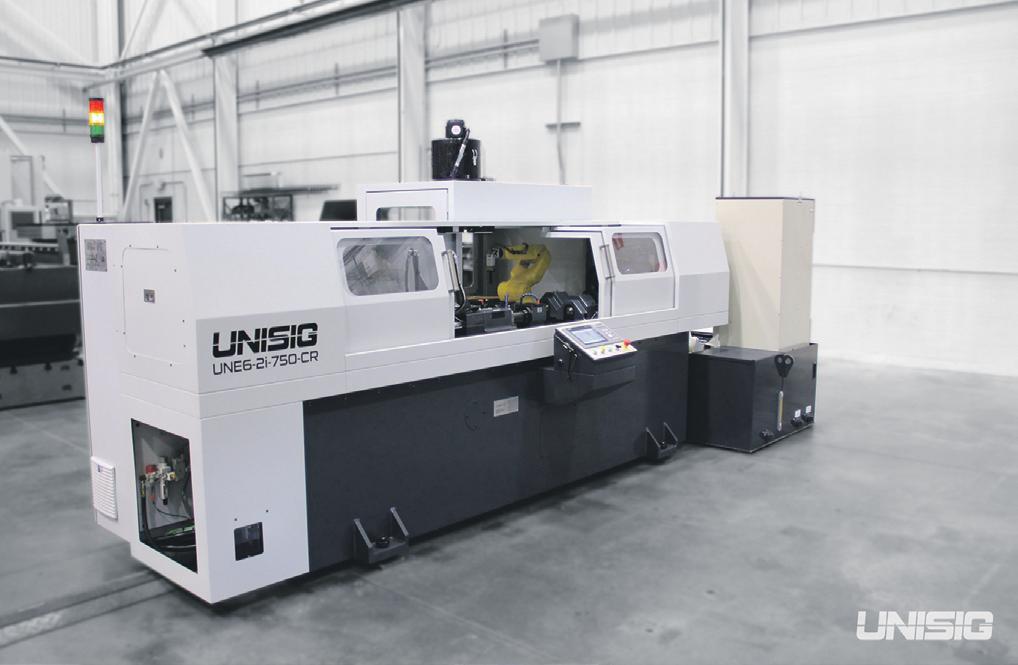
suppliers brings its own problems. Pre-drilled blanks might solve the deep hole drilling problem, but they have to be fed into the machine one by one, defeating the whole purpose of using automation-ready Swiss-style machines. Meanwhile, cannulated bar stock allows shops to continue using their bar feeders, but it’s very expensive – and the hole quality and O.D./I.D. concentricity rarely meet the needs of medical manufacturers anyway.
To overcome these challenges, medical manufacturers are turning to dedicated deep hole drilling equipment to finish instruments started on the Swiss-style machines. With an experienced gundrill operator, careful setup and a bit of finesse, the hole quality can be excellent, and it allows the Swiss-style machines to remain fully automated. The only remaining problem is part handling and transfer which introduces significant risks when the accuracy requirements are so high, and if the part has to be flipped to drill a stepped bore, that introduces more setup operations and more risk of human error.
What medical manufacturers need is a truly end-to-end automated process that allows for an efficient single-piece workflow for surgical instruments – and some deep hole drilling OEMs, such as UNISIG, have engineered all the technology required to meet this goal. The result is a complete system that offers easily automatable, on-demand deep hole drilling processes for the most demanding surgical instrument applications: the UNE6-2i.
As a twin-spindle machine with two independent drilling axes, the UNE6-2i inherently has the capabilities manufacturers expect from a high-performance deep hole drilling machine. Counter-rotation, specialised workholding and superior alignment and precision allow shops to confidently hold concentricity tolerances and minimise mismatches, even at the extreme D:d ratios common in the medical industry. In addition, the UNISIG Smart Control Interface simplifies operation, while an innovative flow-based coolant system automatically reacts to pressure changes for effective chip evacuation and high process security.
What allows the UNE6-2i to truly shine as a part of the surgical instrument production process, however, is the in-machine automation. After the front spindle drills the first hole, a robot takes it out of the spindle, puts the hole onto the second spindle, and loads another fresh blank into the first spindle. The robot’s perfect repeatability ensures the highest hole quality – and the only human labour required for the process is loading bar stock into the Swiss-style machines, preparing the blanks for the UNE6-2i’s robot and sending the finished parts on for post-processing.
The UNE6-2i’s capabilities also give manufacturers significant production flexibility. Two holes with two different diameters could be simultaneously drilled in a single part, or two parts could be in-process simultaneously to allow operators or robots to load and unload the machine without stopping. Alternately, this twin-spindle configuration can be used to drill halfway through a part from one end with the first spindle and allow the second spindle to finish the hole from the opposite end.
Please contact us at: www.unisig.com
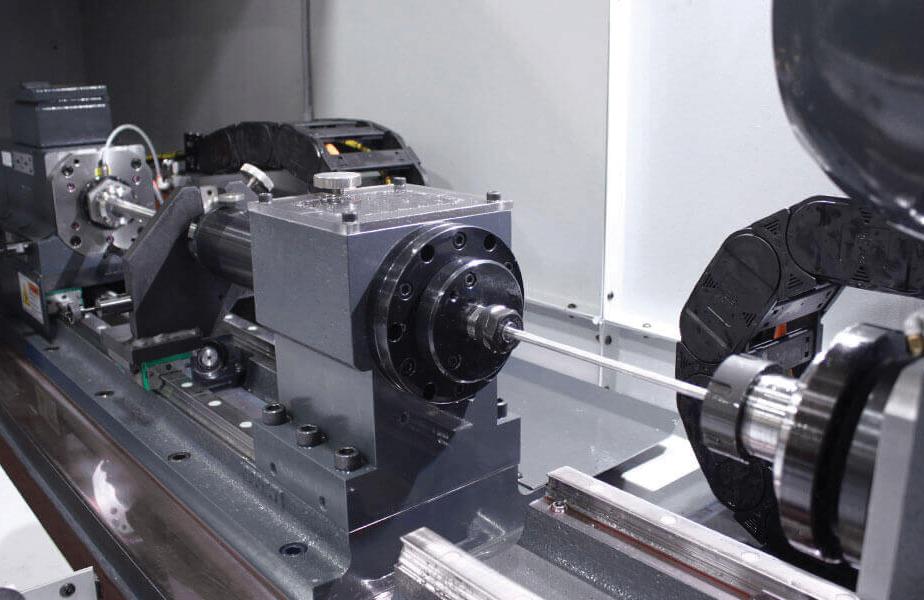
Our proven process: How UNISIG leverages experience & expertise to solve customer challenges

For over 40 years, we’ve helped our customers achieve success in deep hole drilling, providing them with the machines, automation and support they need to be competitive and profitable.
We have found that the initial energy we and our customers spend at the beginning of a quoting process pays off throughout the entire project, from inception to installation. We take a systemised approach not only during this critical phase but also throughout the entire sales process. This ensures there are no surprises and that our customers know exactly what they can expect when starting discussions with UNISIG about their gundrilling and deep hole drilling needs.
This is our approach at UNISIG:
1. We listen to our customers, ask questions and understand what they need.
This may seem obvious, but often the temptation is there to just skip to a quote because we think we know what is needed after a brief discussion. Sometimes that is true, when the application is straightforward and familiar, or it is something we have a packaged solution for. We always try to make the quoting process quick and efficient, but there are times when the application deserves a more in-depth conversation. Our salespeople and engineers listen very carefully and often pick up on small details – a specific tolerance, material condition, process requirement or a future need for flexibility – that may change our recommendations.
When it makes sense, our experienced sales team or engineers will visit a customer to see what is needed firsthand. Whether a site visit or
just a virtual meeting, this initial investment of time to clarify the need saves the customer money and provides them a truly valuable solution.
2 We first identify a standard solution from our product line that can be applied at the lowest cost and shortest delivery possible. At UNISIG, our product development mindset is to systemise solutions from our experience in many different industries, make them automation ready and embed application flexibility whenever possible. We invest millions of dollars annually in our product line and related spare parts, giving us a strong starting point for new applications. Our standard product line encompasses much more than machines, including standard automation, workholding, accessories and tooling that we can offer as part of the solution.
Once we have identified a standard machine as a starting point, our engineers seek out smart, practical ways to meet the customer’s application needs. The goal is to innovate within the machining operation planning, work holding or automation, as opposed to engineering a completely special solution without first exhausting opportunities to solve problems with standard products.
For our customers, this approach provides them a reliable, standard machine that can be used for many years and that has the built-in flexibility for easy re-tooling to adapt to future needs. For us, initially working within the boundaries of our catalogue cultivates new ideas that can then be applied to improve our standard products as well as help us direct future research and development budgets.
3. If a standard solution isn’t available, we consider a customised solution and we stand behind it.
UNISIG is very good at building customised machines, and we do so often. Once we and our customers agree that a special solution is needed, we move forward with a great deal of confidence and experience. We start by evaluating how we might approach the design using standard modules or proven concepts, thus eliminating long debug cycles and/or high costs. Then we use our mechanical and electrical engineering disciplines to virtually test the new machine before we build it.
One of the key reasons our customers are confident moving forward with a UNISIG custom machine is that they know we will stand behind it and that we have substantial capabilities to ensure it always exceeds their production expectations. We approach these special projects with the mindset that a custom machine will be used for decades in production, which is why we provide the same documentation and long-term technical support for all our machines whether standard or custom.
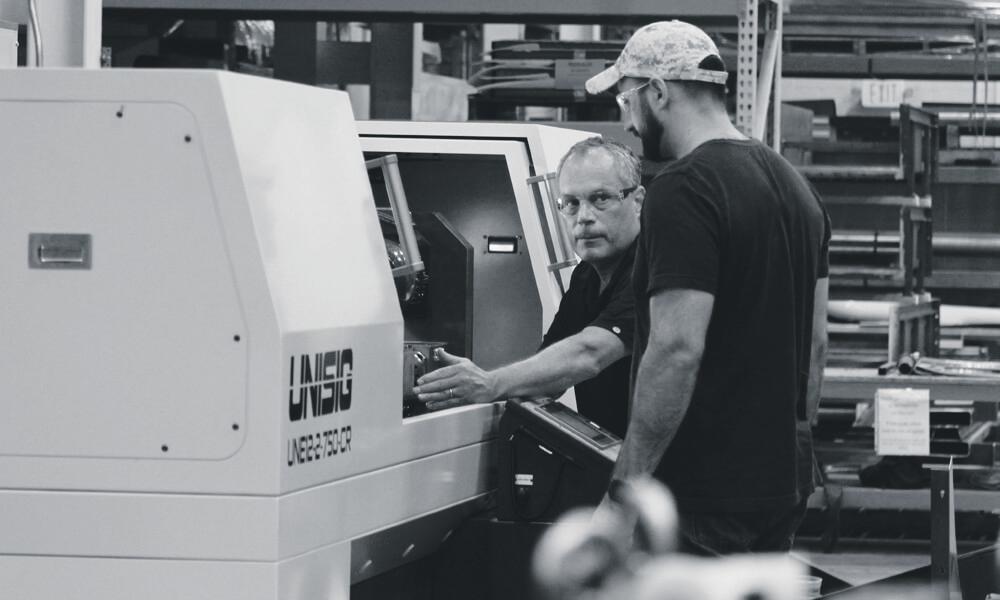
4 If a commodity solution is readily available, we recommend that rather than upsell a machine the customer doesn’t need.
We build machines that can gundrill or BTA drill deep holes that are impossible to drill on machining centres. Even if it may be possible to drill some deep holes on a CNC machining centre, our machines have the power, speed, dimensional accuracy, spindle density, coolant systems and process control that will improve productivity, tool life and reliability.
Typically, though, when a customer comes to UNISIG with a specific part need, at that point they’ve most likely already struggled with a conventional machine and realised that a deep hole drilling machine is obviously the way to go.
However, our team knows how to identify whether or not an application would truly benefit from a UNISIG solution. When it wouldn’t, we will suggest viable alternatives. It’s not that we don’t want to sell a machine. But the fact is that our experience has shown that at some point the alternative-solution direction becomes obvious, and we want to make that apparent early on in the process so as to avoid wasting a lot of our customer’s time.
Our customers expect the best from us, and we believe that our proven process ensures we never disappoint. Our goal is to leverage our core values to serve our customers as best we can and build strong, productive relationships for years to come.
Please contact us at: www.unisig.com
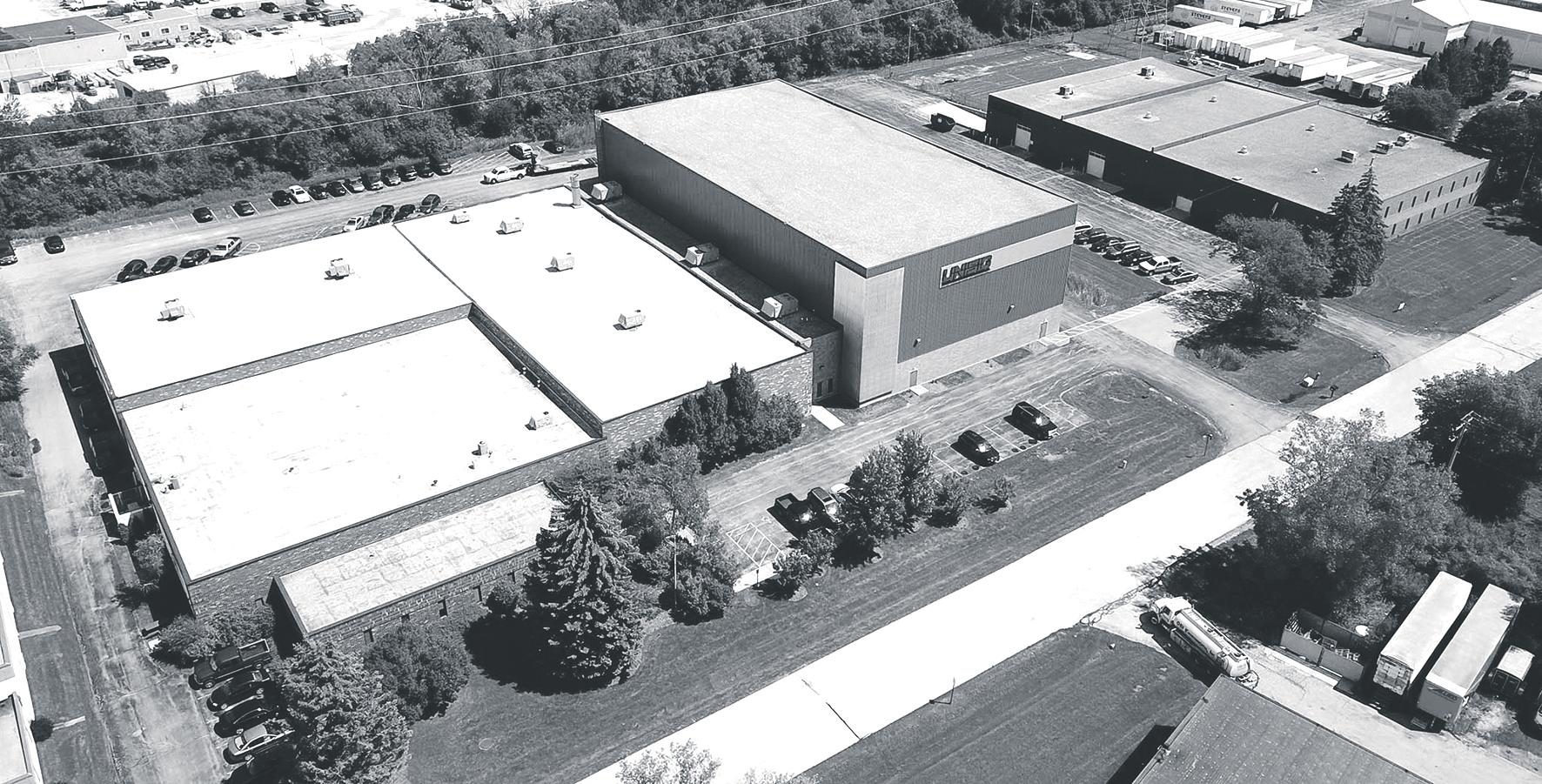
Our industry-leading customers around the world rely on UNISIG® deep hole drilling technologies for powerful, intuitive capabilities. We engineer our machines to handle a complete range of applications, and support them with our high level of expertise and service.
Standard Gundrilling Machines: Job Shops & Production Drilling
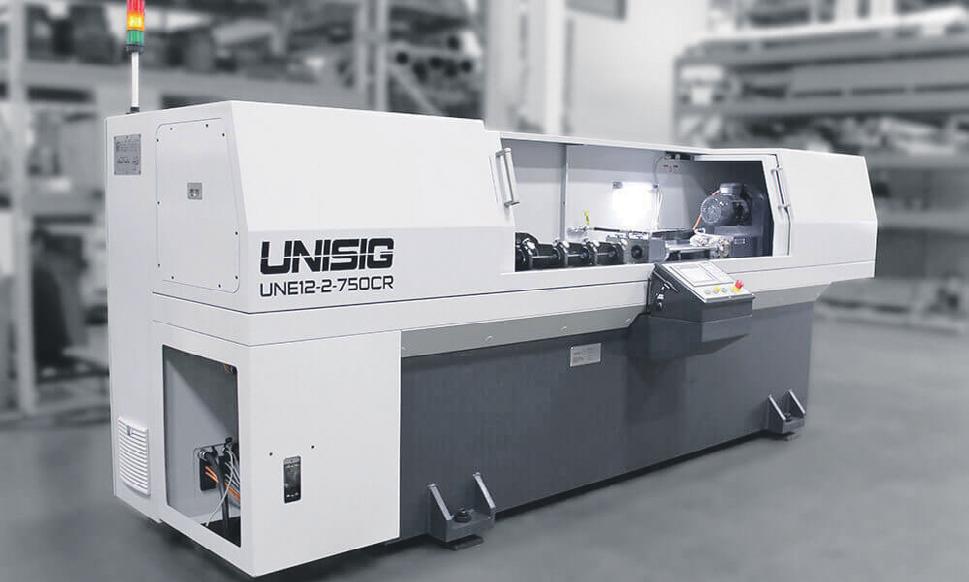
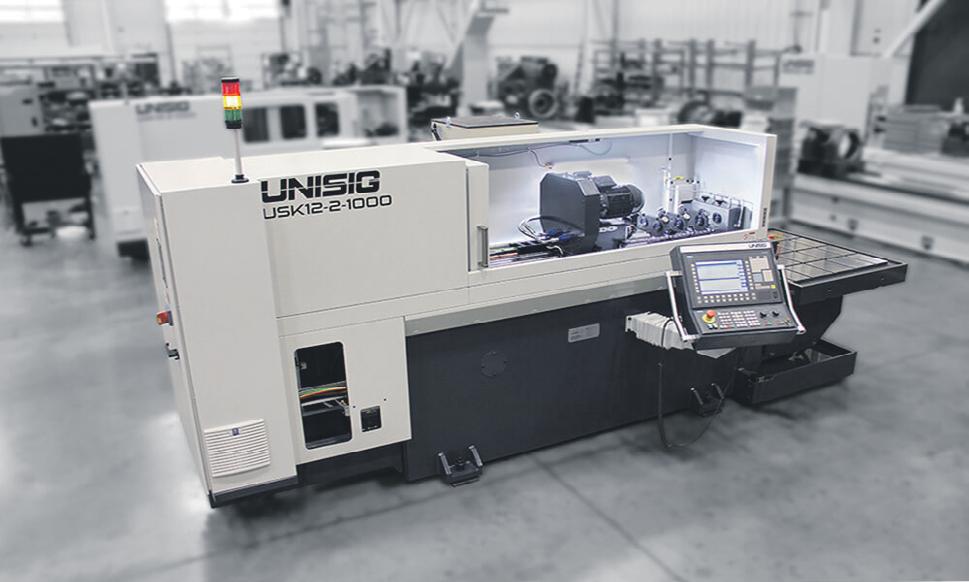




Machines • Tools • Automation
Deep Hole Drilling
UNISIG’s approach to automating surgical instrument manufacturing

As surgical instrument manufacturers pursue greater throughput while facing increased labor costs, automating the medical instrument manufacturing process has become a necessity. However, integrating automation into the gundrilling process for drilling deep holes in extremely precise surgical instruments in lights-out operation is a major engineering challenge requiring more than simply pairing a robot with a deep-hole drilling machine.
The right machine, tools and process must all come together to create small holes with extreme precision in difficult-to-machine materials such as titanium and surgical stainless steel. More importantly, the entire system must flow from a unified concept where the whole is greater than the sum of its parts.
To meet these challenges, UNISIG developed its UNE6-2i-750-CR dual independent spindle gundrilling machine. The UNE6-2i is capable of gundrilling hole diameters ranging from 0.8 – 6 mm in part lengths measuring up to 30 inches with depth-to-diameter ratios from 20:1 to more than 100:1. The machine has a maximum combined drilling speed of 28,000 rpm and a 3,000 psi (207) bar programmable flow-based coolant system with dedicated pumps for each spindle to ensure precise coolant pressure control.
Automating hundreds of cycles of
precision manufacturing, however, is not possible unless the overall operation is considered from the outset. Surgical instrument manufacturing is a sequential process: parts must be loaded into the machine in a particular way for specific operations that happen in a specific order.
Workpiece length, shape and configuration determine where it is gripped by the robot when loaded into a machine, moved from spindle to spindle for drilling, residual cutting fluid removed, and returned to the pallet. Where a part is gripped impacts where it is clamped for drilling to ensure accuracy. Every variable along the process chain must be considered and accounted for, and the calculus is detailed and complicated.
Then there are unique customer needs and requirements. The equipment and process must accommodate a variety of part families and hundreds of parts to increase runtime and efficiency. Operators must be able to change over part types and programming without calling in an automation specialist, and the entire process must be controlled from a central interface. Add to the mix that everything must be packaged in as small a footprint as possible, and the scope of the engineering challenge comes into focus.
UNISIG’s approach to solving these problems, however, results in
targeted automation that enhances the existing benefits of gundrilling, ensuring a solid foundation for reliable process-wide automation.
At its core, the automated UNE62i is a purpose-built machine with automation embedded in its design, not added as an afterthought. Flexibility and adaptability are maximized by a harmonious, interdependent mechanical, software and operational planning scheme.
To meet size constraints, a 6-axis robot was embedded in the machine with a pallet system on the backside of the machine, allowing easy operator access from
the front to setup the machine without compromising ergonomics. The configuration enables quick setup changes between prototype and proving operations and full production runs.
The robot automatically repositions the workpiece from the front of the first spindle into the rear of the second spindle without operator input. The process of drilling a part from both ends in a single-piece flow is unique to UNISIG. Workpieces with enlarged features on one side are loaded from the rear of the collet, solving a common problem in gundrilling medical surgical instruments with full automation.
Control of the UNE6-2i and a computer are consolidated into the Human Machine Interface (HMI), a menu-driven touch screen system for easy, intuitive operation. Training and operator engagement with the system is significantly reduced due to user-friendly UNISIG controller menus and prompts.
UNISIG’s comprehensive and integrated approach to automating medical part manufacturing is a vison that sets it apart in the industry. It’s more than drilling the impossible hole. It’s a commitment to understanding and to the research that drives continuous improvement and innovation for automated part production at its full potential.
Further information on all machines and the complete UNISIG machine program is available at: www.unisig. com or follow the company on LinkedIn and Twitter (@UNISIG).
You will also meet us at the EMO 2023 show in Hannover, Germany, from 18.–23. September.
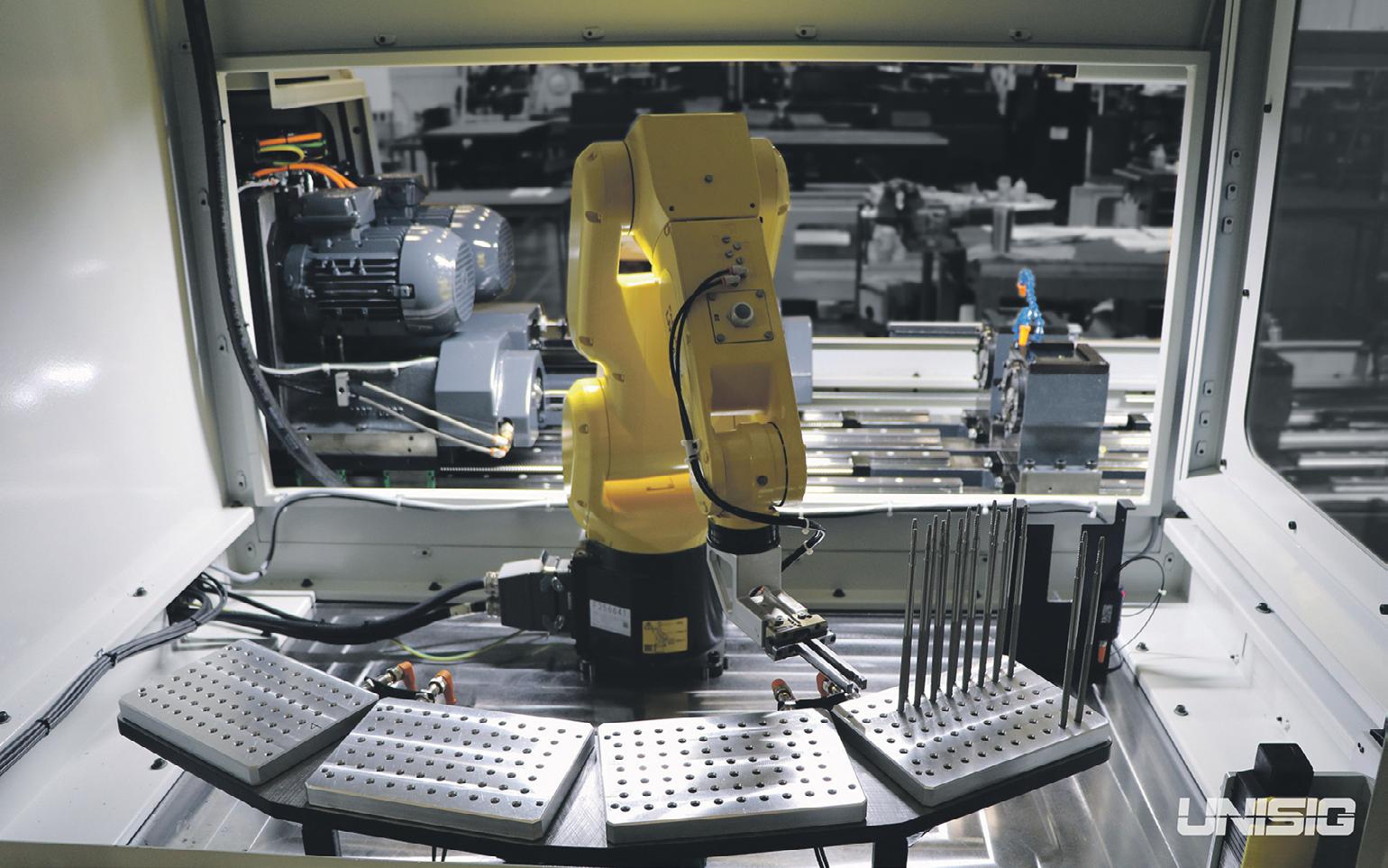

Kardex, creators of the world’s largest portfolio of automated storage and retrieval machines

For many manufacturers and operators of industrial processes, demand is growing for real-time access for replacement inventory and spare parts to ensure uninterrupted operation.

Health & Safety

The use of automated, software-driven machines such as vertical carousels, vertical lift systems, vertical Buffer modules and horizontal carousels for secure storage, safer and faster access to inventory and warehouse footprint requirements, can vastly improve productivity.
S Wasted Space – These solutions make use of underutilised overhead space from the floor to the ceiling with traditional floor space requirement reduced by as much as 65-85%. This can mean the difference between staying put or moving to larger premises.
S Ergonomically – they are designed with the worker in mind by bringing the goods to the person, bending, reaching and carrying is greatly reduced, which is faster and safer for staff.
S Order-fulfilment - When dynamic storage systems are coupled with improved workflow procedures related to order-fulfilment, picking and shipping can drastically improve overall inventory management within the facility
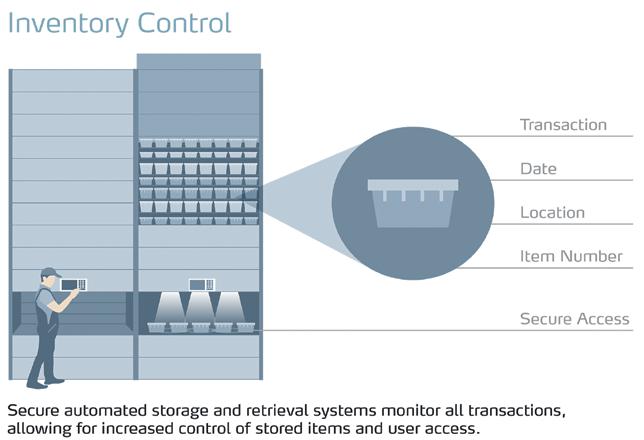
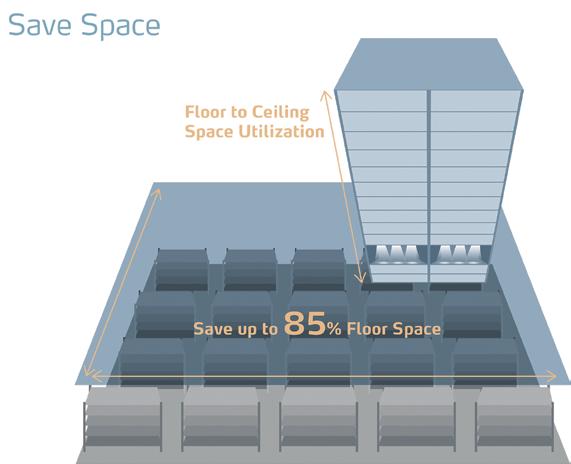
Altair and Cadline Partnership
We are pleased to announce that Altair and Cadline have combined their vast years of expertise within the housing sector, creating a partnership to support customers.
Utilising Cadline’s DynamicAIM product and support, alongside Altair’s sector knowledge and technical expertise, customers will be supported throughout their journey towards Safety Case compliance and the production of a "Golden Thread of Information”.
After the publication of the Hackitt Review, and in preparation for the Building Safety Act, Altair and Cadline are working with multiple registered housing providers to help navigate the shifting landscape and the need to manage a wide range of building information on a much larger scale. By understanding the challenges being faced and using software development skills to streamline existing data management systems, compliance can be more easily achieved.
How DynamicAIM can help
The DynamicAIM system is designed to be tailored to the unique needs of each customer and ultimately facilitate the delivery of safety cases. This starts with the production of a customer specific ‘golden thread’ of information, progressing to identifying data requirements, facilitating data collation, and providing a gap analysis.

Utilising innovative technology, the DynamicAIM web app removes traditional tech barriers when adopting and consuming complex Revit / Plant 3D / GIS and survey data, bridging the gap between design, construction and asset management, without the need for wholesale renewal or replacement of existing databases.
Altair and Cadline can provide support from the initial strategic direction to data review, data collation and input, and can help pull together safety cases by offering a fully tailored solution.
For media enquiries and for any further information, please contact: marketing@cadline.co.uk www.cadline.co.uk
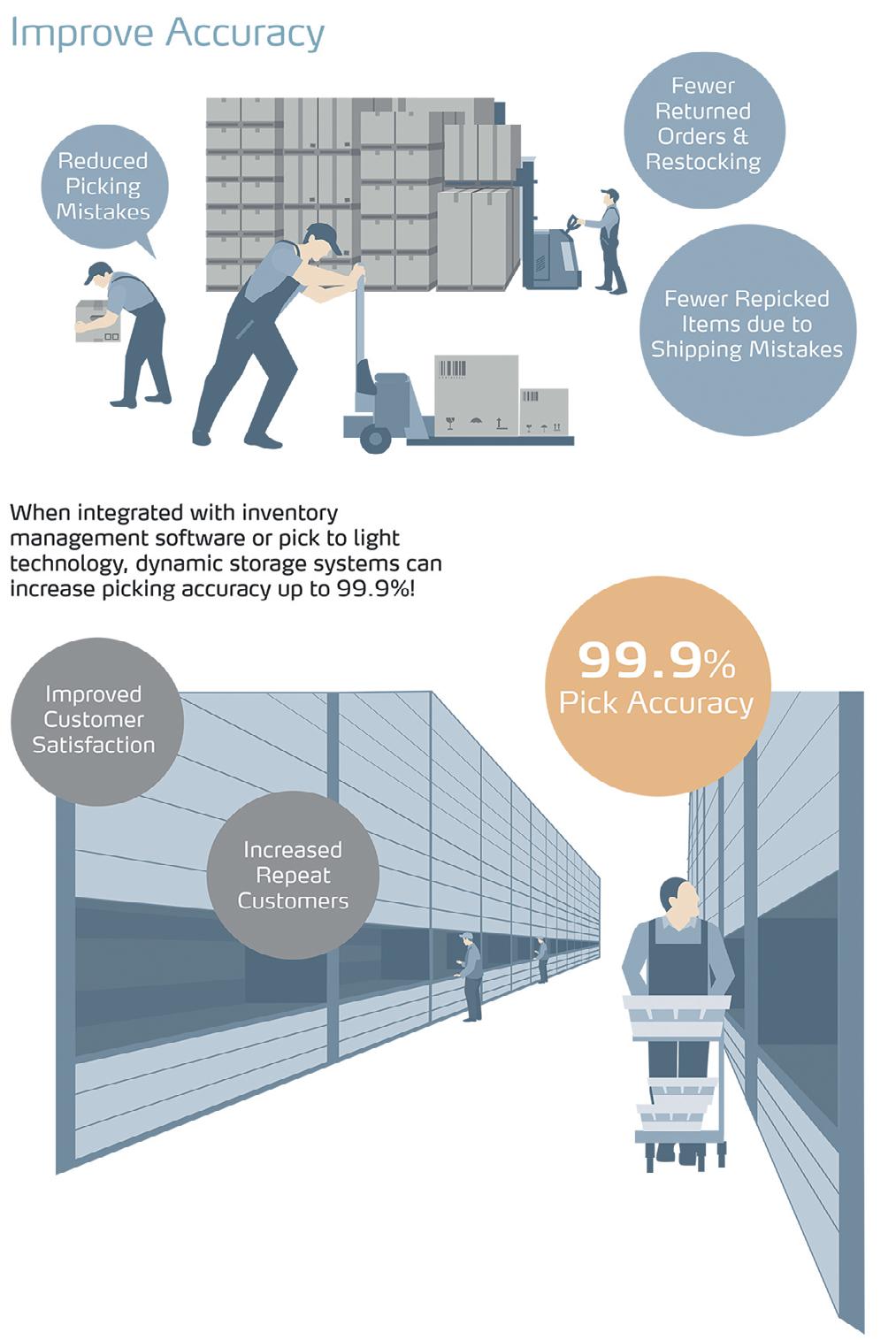
and boost customer satisfaction. This approach will help warehouses and distribution facilities to become more productive and competitive.
To learn more about Kardex automated storage solutions contact Kardex Remstar at info.remstar.uk@kardex.com or visit our website at www.kardex.com
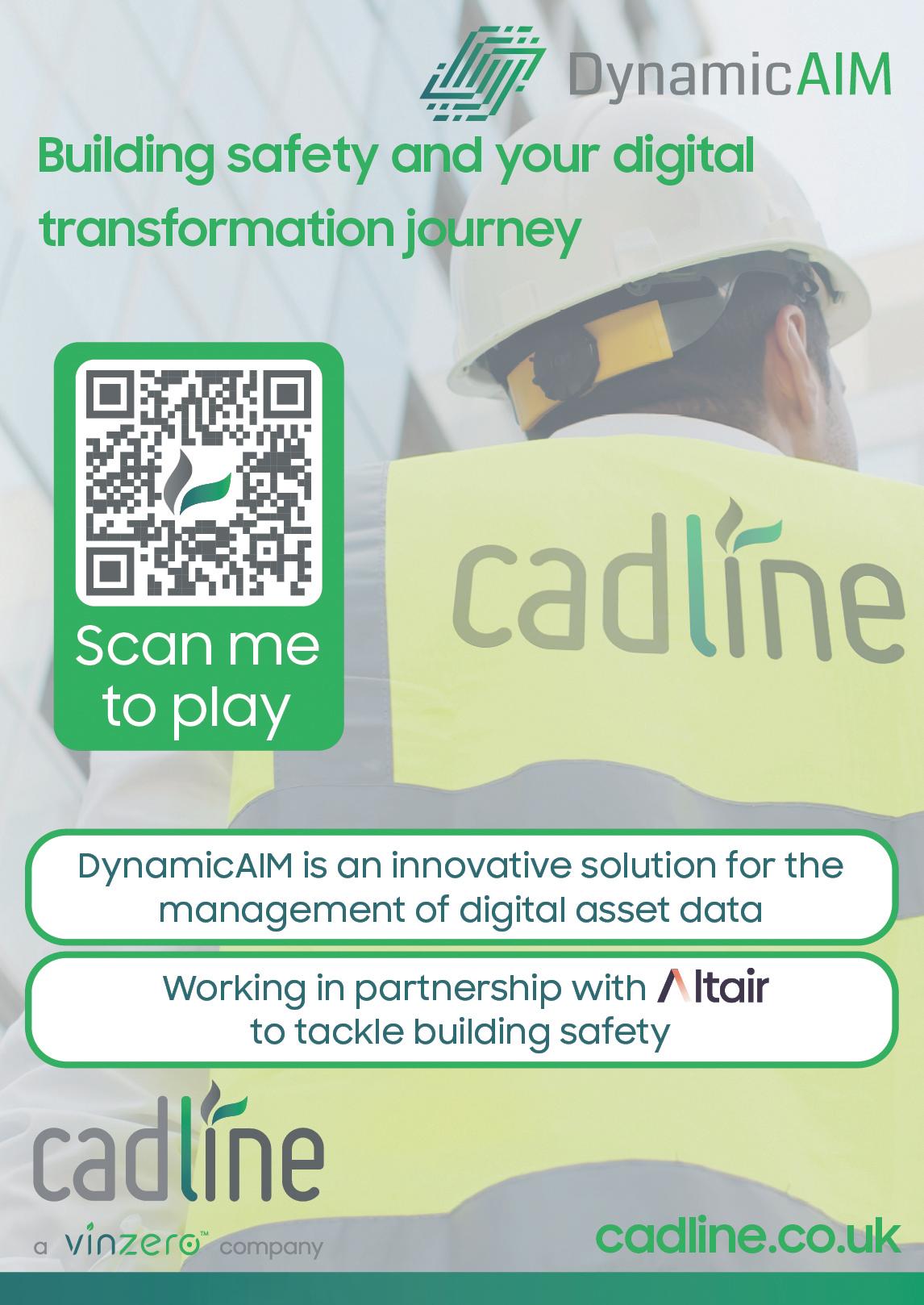
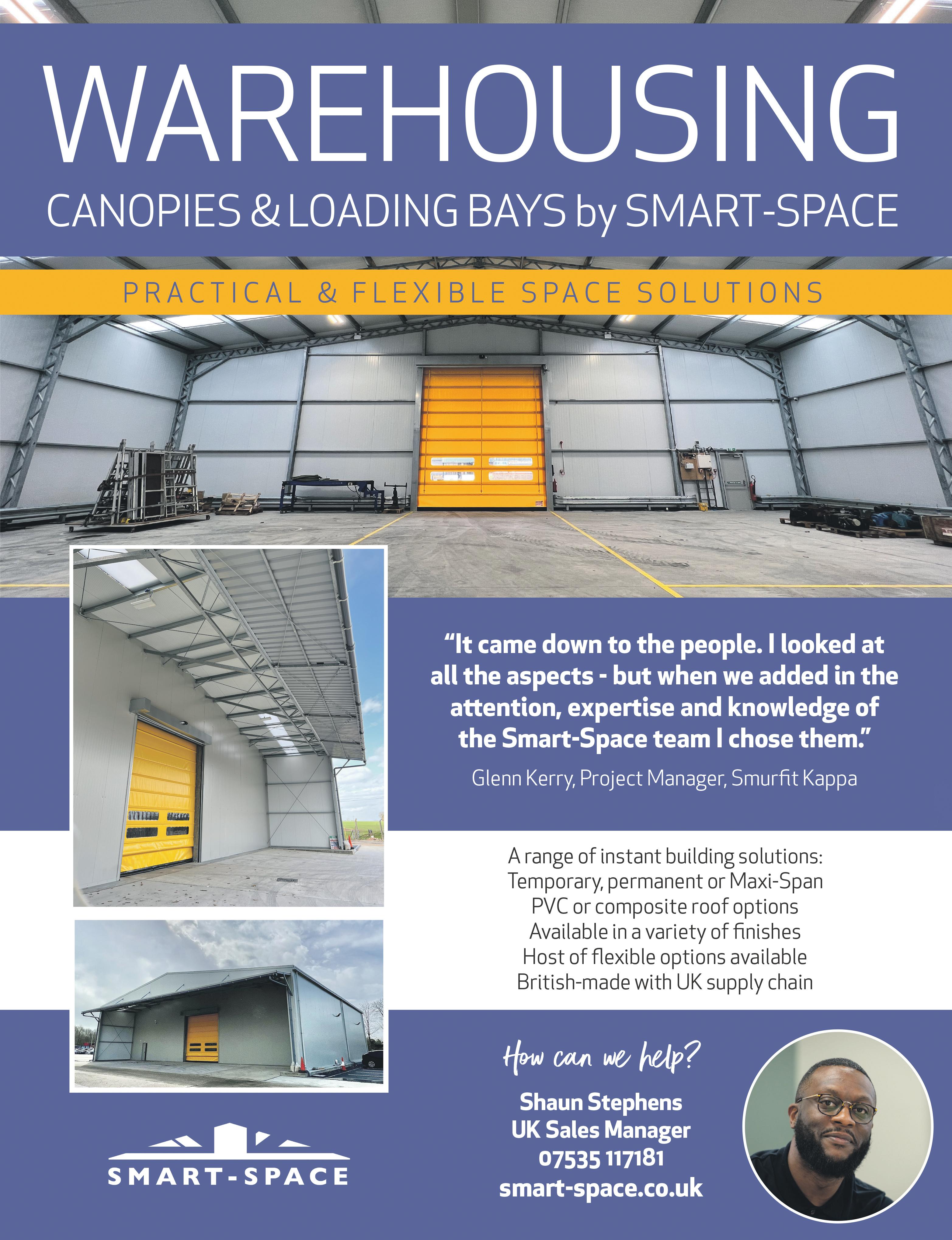
Print & Packaging
Secondary printing (over-printing) onto linerless labels is now possible
Half the cost of adhesive labels is in the cost of the backing paper. Labels are offered ‘linerless’, ie. without backing paper, but instead there is a requirement for a release lacquer on the surface of the label. This does not prevent a preprinted label from being readable, but it will prevent it from being overprinted. Silmark Ltd offers a solution.
Silmark manufactures special inks. Many of
The perfect packaging solutions
Springpack, a packaging specialist, has introduced an online Machine Film Savings Calculator for their nano machine film, Armour Wrap. This calculator allows businesses to assess the potential cost savings and efficiency improvements they can achieve by using Armour Wrap compared to their current machine film.
By inputting their current film specifications into the user-friendly online tool, users can compare and analyse the benefits of Armour Wrap based on industry standards. It's important to note that while the calculations provided by the calculator are reliable, actual savings may vary depending on individual usage patterns.
Armour Wrap stands out due to its unique features and advantages. The film is constructed with multiple layers, providing exceptional strength and load stability, surpassing other high-performance and conventional films. This strength reduces pallet damages, breakages, and movement during transit, ensuring secure packaging.
Switching to Armour Wrap also offers significant cost savings. The film's strength allows for less weight of film to secure a pallet, resulting in less plastic waste and monetary savings. Additionally, each roll of Armour Wrap can wrap around 100 pallets, compared to 70 pallets with conventional films, maximising the packaging output. The film also uses 1kg cardboard cores instead of 1.8kg cores, reducing overall cardboard waste.
Armour Wrap's multi-layer nanotechnology provides high puncture and tear resistance, making it ideal for wrapping pallets with sharp edges. Its increased stretch capability of up to 335% outperforms conventional films, minimizing wastage and delivering optimal performance.
Consistency is key with Armour Wrap, as it is manufactured using top-grade materials and advanced machinery, ensuring reliable and durable performance. The film's raw materials are sourced consistently, eliminating variations in quality between rolls.
Using Armour Wrap also enhances warehouse productivity and efficiency. With more meterage of film per roll, there are fewer roll changes required, reducing film breakages and line stoppages, resulting in a more streamlined workforce.
Springpack sets itself apart by offering customisable solutions tailored to each business's unique requirements. Their team of packaging experts provides guidance throughout the process, ensuring businesses find the perfect packaging solution aligned with their goals.
To begin optimising packaging processes and reducing costs, businesses can access the Machine Film Savings Calculator by scanning the QR code or visiting https://springpack.co.uk/ machine-film-pallet-wrap-savings-calculator. By exploring the potential of Armour Wrap, businesses can take the first step towards efficient and cost-effective packaging solutions.
T 01905 457 000 www.springpack.co.uk

these inks change colour if they are heated, or are exposed to other sources of energy. Accordingly, secondary printing can be carried out using a direct Thermal printer to activate a pre-coated patch of Silmark’s ‘Thermoprint’ ink. The thermoprint can change from white to black, or to one of several other colours.
Silmark also offers a similar system which uses a laser beam. This is non-contact & uses the
light beam from a laser to produce a black (or other colour) image in a patch of special ‘Silmark’ ink. This system is capable of very high speeds.
Contact: Dr J Bannard (pictured) T 0115 9229182 | F 0115 8373556 jbannard@siltechlimited.com www.siltechlimited.com
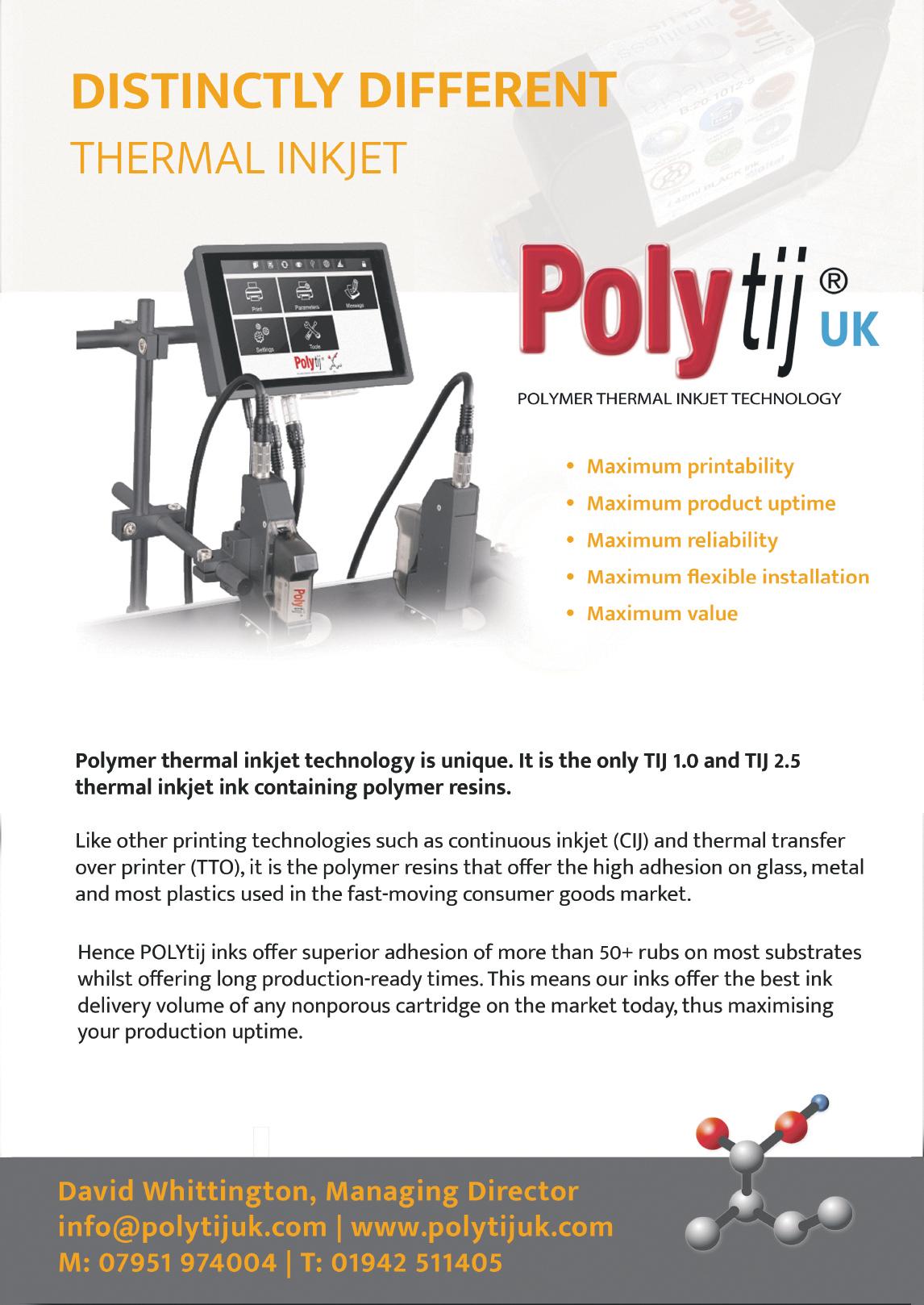




Decarbonising petrochemical refining
Petrochemical processes have traditionally been heated with fossil fuels, but pressure is building to mitigate carbon dioxide emissions and advance long-term decarbonisation goals. Fossil fuel heated processes leave big shoes to fill when it comes to thermal processes, so electric process heaters often raise two big questions: how big can an electric heater be? And what is required to maintain proper control of large electric heaters? Here, Dennis Long, chief system designer at industrial electric equipment manufacturer Watlow, answers these questions and explains why opting for electric is crucial.
The technology behind process heaters has changed dramatically in the last ten years. This is good news for the industry, as electric heaters must be able to provide the same or improved performance that petrochemical engineers have come to expect from fossil fuel powered heaters.
Electric process heaters versus fossil fuel burning heaters
To even consider replacing fossil fuel-burning heaters, we need to have a clear understanding of the current capabilities of electric process heaters. For instance, replacement does not make sense if electric heaters don’t come with the size and power required to heat processes that currently depend on fossil fuels. Many of those processes would require larger electric heaters well above the common one-megawatt (MW) variety such as fluid catalytic cracking (FCC) heaters that require between 150 to 200 MW of power.
With equipment of this size, a single vessel can have two heat exchanger bundles. Such a setup can produce a single process vessel with a 15 MW duty rating or more. The few suppliers providing electric heaters at this scale can raise or lower the duty rating as technical requirements dictate. This kind of size and power presents a viable alternative for operations currently fired by fossil fuels.
Besides reducing the use of fossil fuels, electric heaters and heat exchangers have other welldocumented advantages including less thermal lag, safer operation due to no fossil fuels to burn or
combust and smaller overall footprint.
Maintaining control
Most engineers have never seen electric process heaters and heat exchangers of these sizes or capabilities. So, naturally, some of the most common questions about larger process heaters have to do with control, including what additional elements are needed to ramp up the heater and how that affects the existing electrical system.
Just because larger electric heaters have not traditionally been used to heat all processes in the petrochemical industry does not mean that the technology is untested. In fact, it’s far from it.
Field-proven power switching devices have been used for low voltage electric process heaters and electric medium voltage motors across industries for years, and the ability to control voltage is well established.
Programmable logic controllers (PLCs) bring heaters online in ways that do not cause problems for other devices connected to the same power source. The heater and controller are part of one closed-loop system, which streamlines integration and yields more control over the entire system. This technology’s tried and true nature in other applications reduces the risk for petrochemical process heating.
New tech driving the energy transition It’s worth considering some of the technologies that make electric process heaters and heat exchangers promising candidates for replacing traditional heaters. Heaters with Continuous Helical Flow (CHF) technology are playing a critical role in making large electric process heaters more robust and economical.
CHF ensures the baffles with the heater do not exist as discrete elements, but rather as a single continuous spiral winding around the interior of the shell side of the heater. This forces the flow to be rotational and helical, resulting in an even better heat transfer coefficient per unit pressure drop. This means heaters with CHF technology such as Watlow’s HELIMAX® heat exchanger, do

not have dead zones or areas with insufficient flow. As there are no disruptions to flow, fewer hotspots can develop, subsequently reducing fouling rates.
A single removable HELIMAX bundle can supply up to five megawatts of power duty range, even with a smaller footprint, than fuel-based heat exchangers. Combine this efficiency with the reduced need for maintenance to address coking, and you have a product that increases productivity even as it contributes to decarbonisation efforts.
Furthermore, it’s crucial to have fast, reliable control systems for all larger, modern heat exchangers, especially in petroleum processing, where errors can be extremely costly. Engineers are now beginning to realise two things. Firstly,
there are far more opportunities to use electric process heating systems with far fewer size constraints than energy and environmental engineers previously imagined and secondly, the control of these megawatt size heating systems is demonstrated with precise control of process and skin temperatures.
The industry must break down barriers towards energy transition to provide clean, efficient and reliable ways to electrify processes traditionally heated with fossil fuels. Working with a reliable partner to electrify process heating systems is one of the easiest ways to progress towards climate action goals without interrupting productivity or profitability.
For more information, see below. www.watlow.com
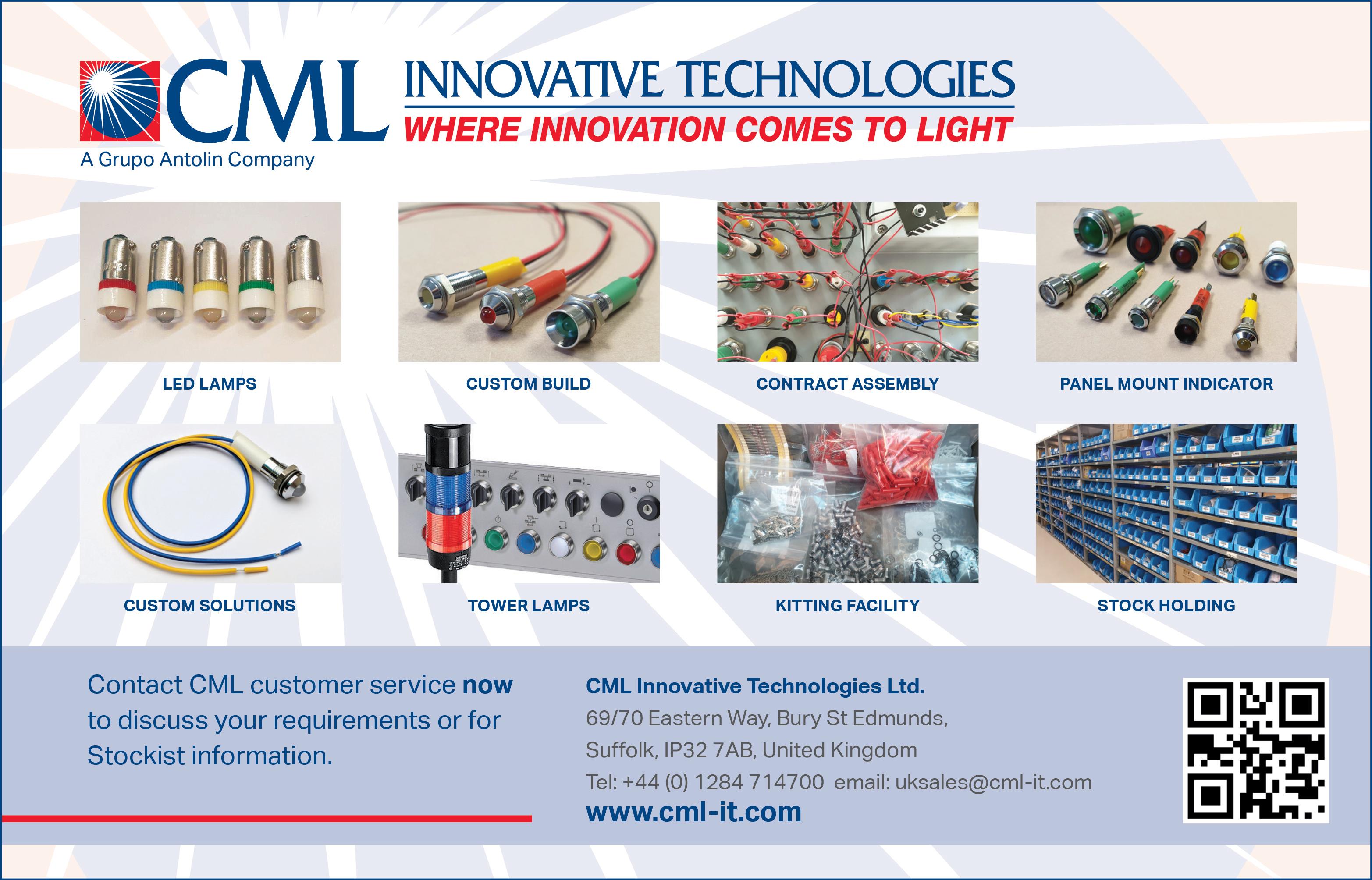
Supporting the dream of green energy, with the help of Industry 4.0 ~ Watlow partners with Raven SR to deliver precise temperature control
The 2015 Paris Agreement has forced many counties to present long-term strategies and nationally determined contributions (NDCs) to reduce emissions. One strategy is to transform waste into usable fuels and Raven SR is a clean fuels company dedicated to achieving this. However, the company uses a process that requires high temperatures and precise control to maintain efficiency and cost-effectiveness. To streamline Raven SR’s energy transformation process, industrial heating technologycompany Watlowprovided extensive expertise in thermal system design, as well as Industry 4.0 control.
Raven SR is a clean fuels company that transforms municipal solid waste, organic waste and methane into high-quality, clean hydrogen and synthetic fuels. These synthetic fuels are Fischer-Tropsch synthetic fuels, meaning that they are produced from a gas-to-liquid polymerization technique that converts carbon monoxide and hydrogen into liquid hydrocarbon fuels that can act as substitutes for petroleum products.
At the heart of Raven SR’s processes is a CO2 reforming process that changes mixed feedstock and organic waste into products in an environmentally friendly way, without the need for combustion. As a result, no emissions are produced — only clean hydrogen and fuels as output.
The work done by Raven SR is a crucial step in achieving clean energy and greater energy independence. Not only does their process create fuel from waste that would otherwise end up in a landfill, but its products can also be created locally and delivered directly to gas stations in the region without the need for longdistance transportation or pipelines.
The challenge
Although combustion is not used as part of Raven SR’s technology, precise thermal control plays a huge part in driving an efficient and safe process. There is already a clear connection between the operational targets that Raven SR is putting forward and the thermal content of the system. At higher temperatures, it’s possible to achieve 99.9 per cent target output, a level of efficiency that also makes the process more cost effective. Achieving the high temperature requires running heaters at their maximum capacity for extended periods of time.
However, those heaters are difficult to replace if something fails. As a result, not only is precise control of temperature needed, but the

entire system also needs to be monitored for any signs of a problem, or for indications of degraded performance.
The power of a complete thermal system Watlow, which has manufactured electric thermal systems for 100 years, provides a breadth of expertise that helped Raven SR to solve its challenge, by designing a comprehensive thermal system from start to finish.
The full thermal system provides an extraordinary range of temperature control through different components. This includes the high-temperature MULTICELL™ heater, which offers three major advantages over other insertion heaters. These are extreme process temperature capability, independent zone control for precise temperature uniformity and loose fit design for easy insertion and removal. The proprietary design of MULTICELL™ heaters with integrated thermocouple sensors, provides a “thoughtful” zoning and control approach, delivering precise control within the three dimensions of the reactor.
Watlow also connected the system to other sensors for gas composition, flow and pressure. Using the WATCONNECT® control panels, comprising temperature and process controllers, it could monitor all thermal and electrical characteristics to ensure proper process stability for the application. Lastly, it’s the connected architecture that makes this system whole.
The Internet of Thing (IoT) “box” is at the heart of the system and includes hardware for connectivity, syncing data from eight F4T® controllers with control loops across four WATCONNECT® panels.
Connectivity to the cloud via a cellular router allows further routing of data to other applications and devices, while a human machine interface (HMI) screen displays the total state of the system at any time using a custom-designed dashboard. These features allow for near real-time data logging and monitoring of system output.
Applying Industry 4.0
This particular project is a great demonstration of Industry 4.0 at work. At a minimum, Industry 4.0 involves a physical layer of interconnected devices, but advanced cases also usea simulation layer that models and predicts the behavior of a system as it unfolds over time.
The sensors, controllers and connectors lay the groundwork for such a system, an important function of which provides a foundation for predictive and diagnostic analytics. One of the chief principles of Industry 4.0 systems is to gather granular data for better system operation while avoiding unnecessary maintenance cycles.
For example, if a system can be monitored and studied in real time, it is possible to look for the indications of a potential part failure, allowing engineers to proactively fix or replace the part.
Over time, this data can also be used to understand system wear and part longevity, allowing engineers to have better insight into maintenance cycles and system inefficiencies — prolonging system lifespan.
Watlow’s sensors, control architecture and dashboard all work together to allow Raven SR’s engineers to capture data and use it proactively to keep system efficiency and uptime as high as possible.
Transforming waste into fuel is one of the most significant ways to become resource efficient and contribute to the Paris Agreement’s targets. Companies like Raven SR are key in driving this, but without thermal systems that encompass Industry 4.0 technology, the efficiency of these crucial processes becomes limited.
For more information about Watlow, Industry 4.0 or environmental applications of thermal systems, visit www.watlow.com. Or, to find out more about Raven SR and its projects, visit www.ravensr.com
Unblocktober founder Lanes Group backs plans to ban wet wipes
National drainage and wastewater specialist Lanes Group plc –founder of Unblocktober, the world’s first campaign to improve our drains, sewers and seas – welcomes proposals to ban plastic-based wipes to tackle water pollution.
The measure is part of a wider Government plan to improve water quality in rivers and other waterways in England.
A ban on plastic-based wipes should come into force in England in the next year after a period of consultation that is due to start this month, the Environment Minister Therese Coffey told the BBC.
Similar bans have been considered in Wales and Scotland but have not yet been imposed.
Lanes Group, the UK’s largest independent drainage and wastewater specialist, founded Unblocktober in 2019 to save sewers, waterways and oceans from sewer misuse.
The wrongful flushing of wet wipes, almost all of which contain plastic, has been a key target of the campaign, the first to encourage people to change their waste disposal habits to prevent sewer blockages and plastic pollution.
Lanes has also launched Microplastics Out of Our Drains (MOOD) a campaign targeted at advocating stricter UK regulations on the use of microplastics in a wide range of products, including wipes and clothing.
Richard Leigh, Group Development Director at Lanes, said: “We very much welcome the government’s announcement that wipes containing plastic should be banned.
“Evidence from Unblocktober make clear the urgent need to take action to reduce sewer blockages and prevent plastic pollution that damages waterways and oceans and wildlife in them.
“The enthusiastic support Unblocktober receives every year, and
feedback from participants, also shows there is very strong public support for banning plastic wipes. I’m sure it’s a measure that will be widely welcomed.”
Wet wipes flushed down toilets are associated with 93% of sewer blockages and cost over £100m a year to clear up, according to water industry body Water UK.
Such blockages can result in local sewer flooding. Also, microfragments of plastic from wet wipes can make their way into waterways, and then out into oceans where they are ingested by fish and other creatures.
The wipes often combine with fats, oils and grease, known as FOG, to form giant fatberg blockages that can fill large urban sewers, causing flooding and undermining wastewater services for thousands of homes, businesses and public buildings.
In 2017, Lanes cleared the infamous Whitechapel fatberg on behalf of Thames Water, a process that raised awareness about serious problems caused by FOG and wipes around the world, and even led to a fatberg exhibition at the London Museum.
Around 90% of wipes sold in the UK contain plastic and should never be flushed down toilets. Only paper wipes that are designated ‘Fine to Flush’ have been shown to break up in sewers, like toilet paper, and so do not increase the risk of blockages or environmental pollution.
Previous government consultation exercises on banning plastic wet wipes have drawn strong public support, with 96% of respondents backing the idea in 2021.
Through its MOOD campaign, Lanes is seeking to raise awareness about the damage caused by microplastics by explaining what they are, as well as facts about how they get into the world’s oceans, along with the impact they have on ecosystems.
Lanes delivers sewer and wastewater systems unblocking and
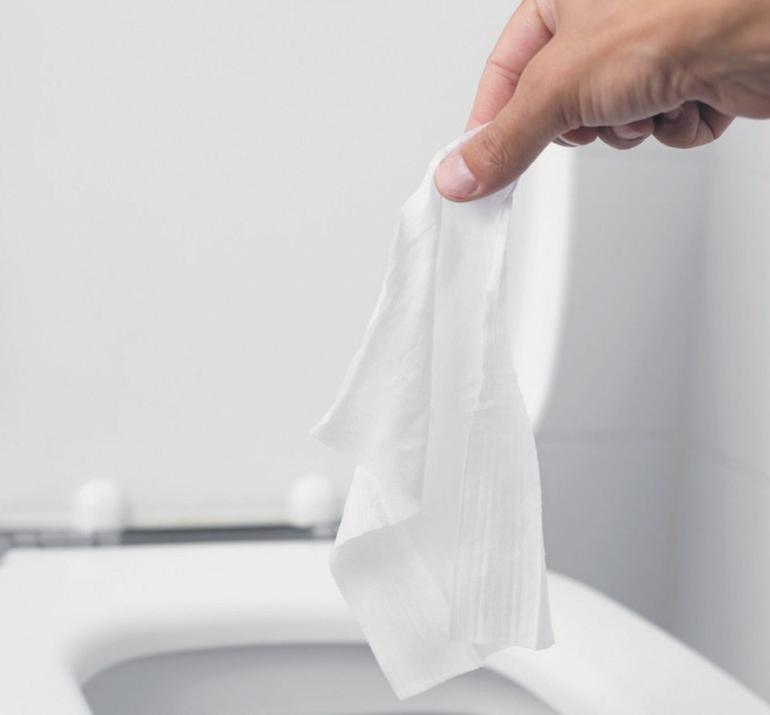
cleaning services for water companies across the UK, including Thames Water, Severn Trent, Yorkshire Water, Northumbrian Water, and Scottish Water.
It also operates a network of 21 commercial depots across the UK, delivering drainage and sewer rehabilitation services to businesses, government bodies, public sector agencies, and domestic customers. For more information, see below. www.lanesfordrains.co.uk
Manufacturing & Machinery
Hygienic, safe and high performing
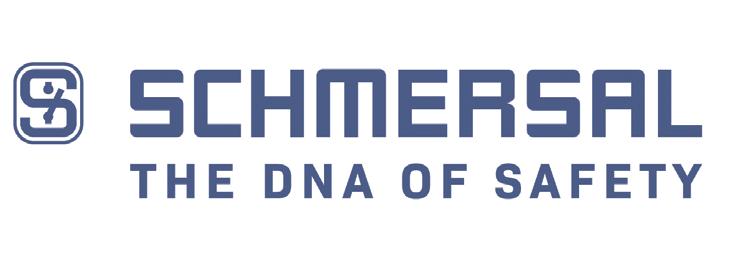
Schmersal at interpack 2023 – new safety and automation solutions for the packaging industry.
Wuppertal, 5 April 2023.
Packaging and process solutions for companies operating in food, beverages, pharmaceuticals and cosmetics will once again be the focal point of this year’s interpack. In Hall 18 / D15, the Schmersal Group will be presenting new products and innovative safety solutions that meet the central requirements of this industry: hygienic design and high plant availability.
New command device series for foodprocessing machinery
The H series from Schmersal will be showcased at interpack 2023 as a full range of command and signalling devices for hygienesensitive applications, particularly food processing. The new H range not only meets the requirements of the new standards for these applications and the ‘hygienic design’ construction principle but is fully modular as well. A total of 147 different devices are available, including 26 mushroom pushbuttons, 24 selector switches and four potentiometer-rotary switches.
New compact safety light barriers for the packaging and food-processing industries
Schmersal has developed the new SLB440 series safety light barriers for hygiene-sensitive applications in the packaging and food-processing industries. With a diameter of 62 mm and a height of 115 mm, the light barriers in the SLB series are extremely compact and achieve protection class IP69. The sealing caps on the SLB440 are made from stainless steel (V4A), while the transparent protective tube is made from robust polycarbonate (PC).
AZM300 solenoid interlock with a hygienic design
The AZM300 RFID solenoid interlock has also been designed according to hygienic design principles. The AZM300 with protection class IP69 is an innovative safety interlock that finds particular use in the foodprocessing and packaging industries. The AZM 300’s features include the patented operating principle with a rotating shaft and star handle. It allows the safety door to be held virtually without play when closed. An RFID sensor is used to identify the actuator reliably, thus providing three different code levels and, consequently, protection against tampering.
The smallest electronic solenoid interlock in the world: AZM40
With dimensions of 119.5 x 40 x 20 mm, the AZM40 is the smallest
electronic solenoid interlock in the world. With these compact dimensions, the AZM40 is particularly suitable for installation on machinery equipped with small flaps or rotating/sliding doors. Due to extensive integrated monitoring functions, the AZM40 can be switched in series with all other electronic safety switchgear from
Schmersal. This makes monitoring multiple safety doors in a single system much easier and more cost effective. The AZM40 is especially suited to use on packaging machinery and in complex packaging lines.
For more information, see below. www.schmersal.co.uk

